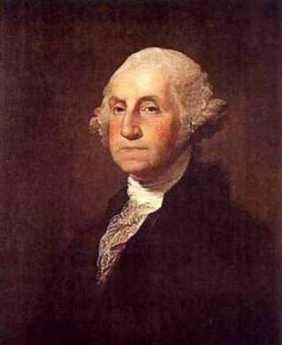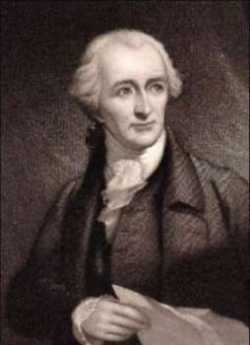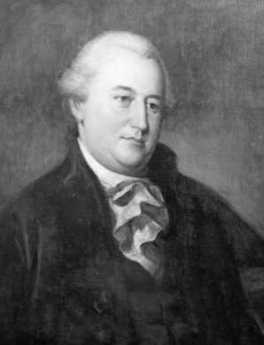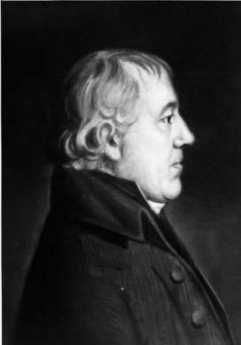1 Volumes
Constitutional Era
American history between the Revolution and the approach of the Civil War, was dominated by the Constitutional Convention in Philadelphia in 1787. Background rumbling was from the French Revolution. The War of 1812 was merely an embarrassment.
Popular Passages
New topic 2013-02-05 15:24:06 description
A Time to Read Books

|
| Retirement Reading |
BEFORE we talk about retirees reading books in a retirement community, reflect for a moment about reading in your own home during the working years. Most suburban homes do not have many books in evidence. It's possible to stand in the center of most suburban living rooms unable to see a single book, while it's hard not to see a television set. Increasingly, a home computer is only a few steps from the front door, but the evolution from desktop to laptop to portable telephone to tablet is too rapid to make generalizations. Everyone says books are going to disappear soon, and newspapers maybe even sooner. But there are still said to be a million books constantly in transit on 18-wheeler trucks between print shops and wholesale depositories, night and day. Right now, the producers, publishers and merchandizers of printed material are in turmoil and decline, so they talk about it a lot. But ultimately it is the reading public which will decide what it wants and force the suppliers to give it to them.

|
| reading |
It seems to me that what the reading public wants most is to find time to read. The suburban home has so few books because the sort of person who lives in the suburbs to be near the school system, just doesn't have time to read after the day's work and commuting. Helicopter parents spend a lot of time hauling the kids to mandatory kid entertainments, as can easily be seen by driving past a high school in the afternoon and observing the lines of cars with waiting mothers. They make the best of it as a social occasion for mothers with shiny cars, but they really do it to be sure the kids don't get mixed up with recreational drugs. Anyway, they do it, and it all eats up their discretionary time for reading. Meanwhile, their's no local bookstore to buy books, even unread books. They may think they will catch up on their reading after they retire, but that's becoming increasingly unlikely in my observation. They are getting out of the habit of reading. By the time they retire, they will find it's almost like going back to school. You must find other readers, readers groups, conversations about books over the bridge table, books lying about. The first economy a struggling news paper makes is to cut down the size and number of book reviews, because there are no bookstores to take out advertising, and advertising is what pays for newspapers. There's one good feature about that; what book chatter there is, is not so confined to recent books. Some people are bookish and other people are golf-ish, and a growing number of people are simply TV-ish. It's a struggle to find time for work and the family, and books on top of that. No matter what level of reading the working people may be doing, it's declining in favor of deferred reading when they finally retire.

|
| Retirement Community |
Having visited quite a number of retirement communities, I find the community's library is a good place to assess the institution and its typical inhabitant. When it's newly built, a library area is set aside, usually without many books. The first few waves of residents quickly fill up the space with books they brought from home. During the first ten years it is possible to guess what sort of person lives there by the books they brought and deposited, or died and left to the library. The space, more or less empty at first, gets full and something must be discarded. Enlarging the library is an economic issue, so the size at which it halts will to considerable degree reflect the willingness equilibrium to pay for new construction, both by the book lovers, and by the book enemies, the golfers and the administrators. Ultimately book congestion gets to the point where someone simply must cull out some old books to make room for the new. In another essay I have described the use of volunteers to exchange books of no lasting interest for more books of real interest to real residents, through a used-book exchange. But someone must organize the process, often recruited by an administrator who has learned to be horrified of construction which cannot be rented, but must be cleaned and cared for. If passive resistance is a new term to you, this is the place to learn about it. The residents have short memories, lack drive and follow-through. So inertia tends to win, and lack of reading feeds on itself because there is nothing to read. What's apparently needed here is an organization of bookish people that extends to all retirement communities, probably with a paid staff, an annual meeting, Internet connections. And therefore an immortality which can outlive and outlast the passive resistance. Good ideas then have a means to spread and help support other good ideas; somehow the costs must be supported until a few True Believers in Books can write a bequest in their wills to sustain it. And activate their intention, so to speak.
One of the largely unrecognized reasons for the success of the American Revolution was that the Colonies had a higher level of literacy than the Mother Countries. Thomas Paine, for example, printed 150,000 copies of Common Sense on the rickety old printing presses of the 18th century, when there were fewer than three million white inhabitants of the thirteen colonies. And who was mainly responsible for that? It was Benjamin Franklin with his invention and popularization of the lending library. If Ben could find time to start libraries in 1742, and Andrew Carnegie was later found willing to pay for dozens of them, surely the time and energy can be marshaled in the 21st century to establish a first-class library system throughout the retirement communities of the nation.
Germantown Nurses the Yellow Fever, 1793
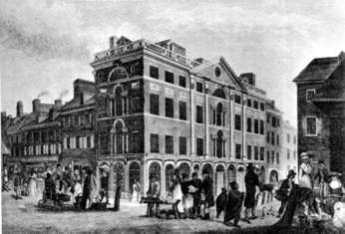
|
| Yellow Fever, Phila |
The French Revolution continued from 1789 to 1799 and created the opportunity for a second revolution in the New World which a second overstretched European country would lose. The slaves of Haiti just about exterminated the white settlers, except for the few who escaped, taking Yellow Fever and Dengue with them. Both diseases are mosquito-borne, so they flare up in the summer and die down in the winter, although the Philadelphians who welcomed the exiles didn't know that. Yellow Fever in Philadelphia was bad in 1793, came back annually for three more years, and flared up once again in 1798. It could be easily observed to be more frequent in the lowlands, absent in the hills. Seasonal, it reached a peak in October, disappeared after the first frost. In the early fall, people died a horrible yellow death, jaundiced and bilious.
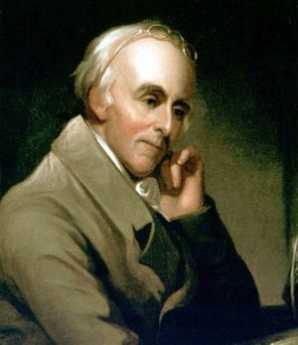
|
| Dr. Rush |
The Yellow Fever epidemic had a profound effect on many things. It was one of the major reasons the nation's capital did not remain in Philadelphia. It made the reputation of Dr. Benjamin Rush who announced a highly unfortunate treatment -- bleeding the victims -- thus provoking numerous anti-scientific medical doctrines based on the relative superiority of doing nothing at all. In Latin, Galen had capsulized the doctrine of Hippocrates in the "Epidemics" as premium non-nocere ("At least do no harm.") It took a full century for American scientific medicine to recover from this blow to its reputation. Whatever criticism Rush may deserve for his Yellow Fever blunder, it definitely is not true that he was a scientific lemon. Medical students are regularly surprised to learn that he is the physician who first identified and described the tropical disease of Dengue, or "break-bone fever", which was a somewhat less noticed feature among the Haiti exiles in Philadelphia. In still other scientific circles, Benjamin Rush is often referred to as the "Father of American Psychiatry". He was one of the founders of the College of Physicians of Philadelphia, the oldest medical society in North America. Medical colleagues who today scoff at the yellow fever episode seem to forget that Rush stayed behind to tend the sick during a devastating epidemic, while many of his more cautious colleagues fled for their lives. An unhesitating signer of the Declaration of Independence, whatever Rush did, he did courageously. Non-academic physicians have sarcastically referred to this episode ever since, as proving that "some people" think it is "better to publish than to perish".
One very good non-medical thing the Yellow Fever epidemic accomplished was to put an abrupt end to the torch-light parades of window-breaking rioters agitating, with Jefferson's approval, for an American version of the guillotine and the terror. Federalists like John Adams and William Bingham never forgave Jefferson or his admirers for this, so the class warfare movement might likely have got much worse if everyone had not suddenly dropped tools, and headed for the hilly safety of Germantown.
The President of the new republic, George Washington, was in Mt. Vernon in the summer of 1793, wondering what to do about the Yellow Fever epidemic, and particularly uncertain what the Constitution empowered him to do. He finally decided to rent rooms in Germantown and called a cabinet meeting there. His first rooms were rented from Frederick Herman, a pastor of the Reformed Church and teacher at the Union School, although he later moved to 5442 Germantown Ave, the home of Col. Franks. Jefferson chose to room at the King of Prussia Tavern.
During this time, Germantown was the seat of the nation's government. As was fervently hoped for, the cases of yellow fever stopped appearing in late October, and eventually, it seemed safe to convene Congress in Philadelphia as originally scheduled, on December 2.
Although Germantown was badly shaken by the experience, it was a heady experience to be the nation's capital. Meanwhile, a great many rich, powerful and important people had come to see what a nice place it was. Germantown then entered the second period of growth and flourishing. Walking around Germantown today is like wandering through the ruins of the Roman forum, silently tolerant of visitors who would have never dared approach it in its heyday.
REFERENCES
| Benjamin Rush: A Discourse delivered before the College of Physicians of Philadelphia: Thomas A. Horrocks ASIN: B0006FCBXS | Amazon |
| Bring Out Your Dead: The Great Plague Of Yellow Fever In Philadelphia In 1793: J.H. Powell ISBN-13: 978-1436715881 | Amazon |
| Germantown and the Germans: An Exhibition from the Collection of the Library Company of Philadelphia: Edwin, II Wolf ISBN-13: 978-0914076728 | Amazon |
Two Friends Create the Articles of Confederation
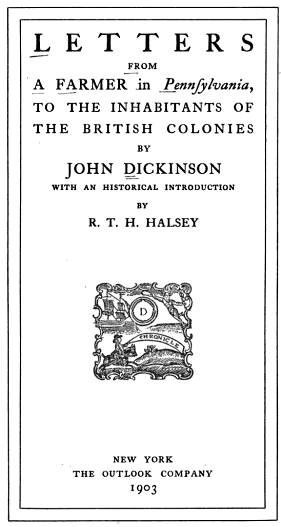
|
JOHN Dickinson had been highly critical of England's treatment of its colonies. As early as 1768 he had written a book called Letters of a Pennsylvania Farmer which is credited with strongly influencing the colonies in the direction of resistance to the British Ministry. When it came time to write the Articles of Confederation, Dickinson was the lawyer selected for the task. His good friend Robert Morris had been less outspoken in opposition to the Ministry's behavior, quite possibly because he was adept at finding workarounds for his own personal business problems. But possibly he was merely maintaining an ambiguous negotiating posture, since in a hotly contested election with this as the main issue, Morris was elected by both sides in the argument. When July 4, 1776, forced the issue both Dickinson and Morris had refused to sign the Declaration, but within a few months both of them were actively fighting for the Rebellion. The truest test of their evolving attitudes might have emerged when Lord North sent the Earl of Carlisle as an emissary after Burgoyne's defeat at Saratoga, offering peace with a sort of commonwealth status for the colonies. Not much is written about this curious episode, leaving it unclear whether the British were serious, and even if they were, whether the Americans understood the offer as serious. On the surface, the British offer conceded taxation with representation as the rebellion had been demanding. But it was rejected by Gouverneur Morris acting for -- who remains unclear. It seems possible the British were exploring the true feelings of people like Dickinson and Robert Morris but were disappointed. The earlier treatment of Ireland after it had agreed to a similar half-hearted autonomy did leave British sincerity in legitimate doubt.
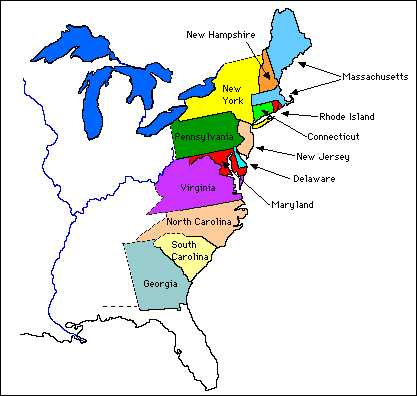
|
| Thirteen |
The thirteen colonies had united to fight the British King, but many of them were reluctant to unite for any other time or purpose. Rhode Island was perhaps the extreme example of this view of what Independence was supposed to mean, but the feeling existed to some degree in many colonies. Concern for the power of this feeling of tentativeness may have contributed an important reason the Articles placed heavy emphasis on declaring the document to represent a perpetual arrangement. Recognition of the weakness of this intent may have been an important reason why George Washington was later willing to sweep the issue aside, even though he of all people was most concerned to avoid the appearance of acting as an arbitrary king. For these and other reasons mainly revolving around state boundary disputes, the Articles remained unratified for years. Finally, in 1781 Robert Morris became convinced that failure to ratify was encouraging the states not to cooperate, and successfully pushed ratification through its steps. At that time, Morris was effectively running the country, even providing his own credit and funds to do it. People were reluctant to oppose his wishes, but they were also unwilling to provide the taxes, supplies, and troops that Morris imagined were being blocked by failure to ratify. Ratification of the Articles accomplished very little except to convince Morris: the Articles were flawed and must be replaced with something conferring more central power.
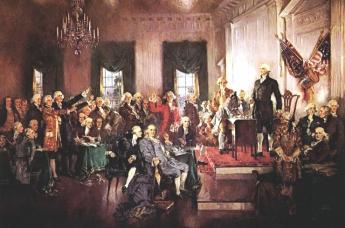
|
| The Goal: 1787 |
Little is known about the evolution of Constitutional thought in Morris' mind between 1781 and the Constitutional Convention in 1787, although a great deal is known about his other numerous activities. It is clear, however, that his experience with the recalcitrant Pennsylvania Legislature had been dismal, while he came to see the one insurmountable flaw in the current Federal government was its inability to levy taxes and consequently, to service national debt. The states were able to levy taxes under the Articles but erratic in doing so, resorting to paper money inflation at the first sign of tax resistance. In Morris' view, the key to the effective government was to reverse the situation; let the national government tax, let the states spend. The key to such rearrangement would be to permit the national government to spend on a very limited list of vital purposes, but bedazzle the states with a substantially unlimited shopping list if they thought they could afford it. As the accounts to pay for the Revolutionary War totaled up, it was apparent that the National Government had twice as much debt as the states. Therefore it would at most, need twice the state taxing power to service such a debt; presumably, wars would be infrequent and it would be less than that. Pay this one off, and potentially the need for future federal spending would be small. Indeed, under the presidency of James Monroe, the national debt was completely paid off, although briefly. It was almost as if Robert Morris and his pupil Alexander Hamilton had a crystal ball.
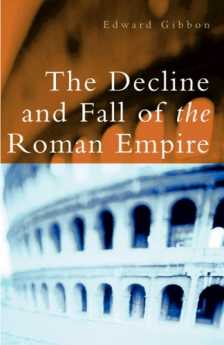
|
| Decline and Fall, Anyone? |
Robert Morris was brilliant and had six years to fashion his strategy, but he also had some help. For one thing, George Washington lived next door much of that time. By then, almost no one dared confront Washington. Adam Smith had written his book The Wealth of Nations in 1776, and Morris gave this extraordinary work as presents to his friends. Morris had corresponded with Necker, the genius financier of France, and through his good friend Benjamin Franklin, gathered insights from the rather advanced British national finance. And James Madison brought in scholarship about politics and statecraft accumulated by Witherspoon, Hume and the Scottish enlightenment. The year 1776 was a remarkable moment for new ideas. In that year, Edward Gibbon also published the first volume of The History of the Decline and Fall of the Roman Empire. The warning behind that important book had an important impact on the minds of important thinkers of the era, too.
Once you grasped all the central ideas, in this environment the resulting strategy almost worked itself out.
Signers and Non-Signers of the Constitution
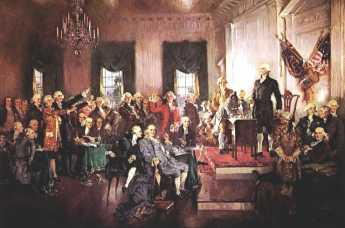
|
| Signers of The Constitution |
John Dickinson was active in designing both the Declaration of Independence and the Constitution, but he signed neither one. His position on the Declaration was that England had behaved in an offensive way; but the situation was getting better and it was still possible to patch things up, even with a British fleet in New York harbor displaying hostile intent. His later position on the Constitution is less clear. Dickinson asked George Read to sign his name because he was sick. Whether this was a real illness or a diplomatic illness is not readily known.
Three active delegates made no bones about their opposition to the final product: Edmond Randolph and George Mason of Virginia were not mollified by private assurances that a Bill of Rights was necessary but could be added later. They refused to sign a constitution that did not currently include this most passionate of their demands. There is little doubt of their sincerity, but any politician today would recognize they also needed to protect their flank from Patrick Henry who stayed at home denouncing the whole enterprise. Henry was a powerful speaker, representing the Scotch-Irish Virginia Piedmont area. In Scotland, Ireland, and America, that group had been abused by English kings three times and wanted iron-clad protection against backsliding to English rule or English government models. It's quite possible that Virginia's George Wythe and James McClurg left the convention early in order to avoid the local political consequences of signing the document, or the equally uncomfortable stance of opposing George Washington. The sentiments of Virginia can be surmised when of the seven delegates sent by Virginia, only John Blair joined the two instigators, George Washington and James Madison in announcing their approval. A majority of the Virginia delegation was thus held back on ratification until only one last vote was needed for enactment. Without George Washington, there can be little doubt the whole effort would have failed. Indeed, a case could be made that the location of the District of Columbia and the election of Virginians as four of the first five presidents also has the appearance of trying to persuade the six hundred pound Virginia gorilla to play nice.
Elbridge Gerry of Massachusetts similarly refused to sign any constitution which did not include a Bill of Rights. However, Gerry undermined his stance on principle by inventing the technique of packing his opposition into one voting district (by shifting its borders) so his own party could win narrow majorities in several other districts. This sleazy manipulation of loopholes in the system has become known as Gerrymandering and raises a question perhaps unfairly, of where Gerry actually stood on every other issue in the Constitutional Convention. By contrast, it is impossible to imagine George Washington doing such a thing, and quite possible to imagine he would never again speak to someone who did.
In addition to the three delegates who stayed to the end but refused to sign, an additional four left early to demonstrate their protest: John Lansing and Robert Yates of New York; and Luther Martin and John Mercer of Maryland.
We are left less clear about the opinions of seven more who simply left the convention early (Oliver Ellsworth of Connecticut, William Houston and William Pierce of Georgia, Caleb Strong of Massachusetts, William Houston of New Jersey, and William Davie and Alexander Martin of North Carolina.) The same uncertainty extends to the eighteen delegates who were invited to attend but either refused or regretted their inability to attend: (Erastus Wolcott of Connecticut, Nathaniel Pendleton and George Walton of Georgia, Charles Carroll, Gabriel Duvall, Robert Hanson Harrison, Thomas Sim Lee, and Thomas Stone of Maryland, Francis Dana of Massachusetts, John Pickering and Benjamin West of New Hampshire, Abraham Clark and John Neilson of New Jersey, Richard Caswell and Willie Jones of North Carolina, Henry Laurens of South Carolina, and Patrick Henry, Richard Henry Lee, and Thomas Nelson of Virginia). These men were originally selected because of their local eminence, so some of them may have been unable to spend several months in a City that took days to reach on horseback. On the other hand, we certainly know where Patrick Henry stood, and a large number of other abstentions from certain states suggests more than personal inconvenience was involved. After all, Rhode Island refused even to nominate anyone to the Delegation. In this last case, a political issue was highlighted. The Articles of Confederation which were being replaced not only required unanimous consent to change them, but they affirmed the Articles to be permanent. Under ordinary contract law, that would be dispositive. But George Washington was hell-bent on replacing the Articles of Confederation, so what they said would then no longer matter.
There remains a need for someone, perhaps in a doctoral thesis, to examine the voluminous correspondence and recollections of the large group of non-signers to assess the true nature of their failure to attend or sign. There was plenty of room for honest disagreement, personal business back at home, illness, or feelings of inadequacy. On the other hand, plenty of other subsequent politicians have exhibited an unwillingness to offend anyone, a hope to seek advantage from both sides, or a habitual tendency of waiting to see who would win before stating an opinion. Politics would be better without such personal inadequacies, but politics would not be politics without them. In fairness to their quandaries, the voting on the Constitution was by states, requiring nine to adopt it. If the vote of their state was a foregone conclusion, some delegates probably had a right to go home and let it happen in their absence. In the case of Alexander Hamilton, here stood the sole New York delegate in attendance at the final signing. Since he had been agitating for this sort of reform for seven years before Madison and Washington convinced each other, it seems possible that others withdrew to let him have the limelight. There is little doubt the single remaining responsibility of the signers was to go home and "deliver" their state for ratification, and Hamilton went at that with a vengeance. Although the moment of final signing appears on portraits and in sculpture, it was only the beginning of the battle for adoption, not the final victory. Indeed the Constitution as we now perceive it did not take more or less final form until the early government shaped its operation in actual practice. Most of that shaping process also took place in Philadelphia, during the first ten years while the seat of government was still located there. In particular, many if not most of the elected members of the First Congress had been members of the Constitutional Convention, returning to Philadelphia to finish the job by writing the Bill of Rights.
|
|
|
| |||||
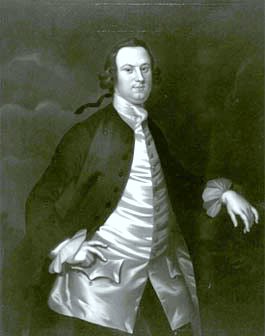
|
||||||||
| Daniel Carroll |
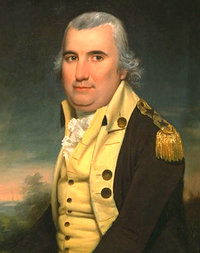
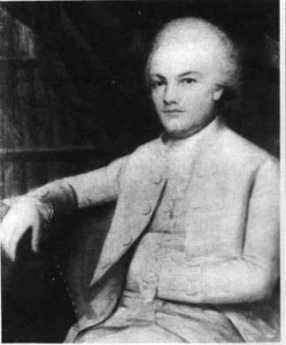
|
| Charles Pinckney |
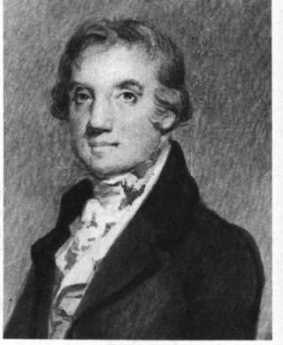
|
| Abraham Baldwin |
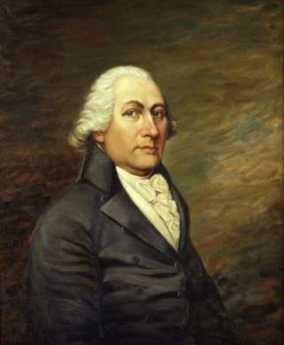
|
| John Langdon |
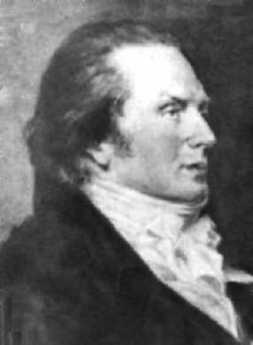
|
| Nicholas Gilman |
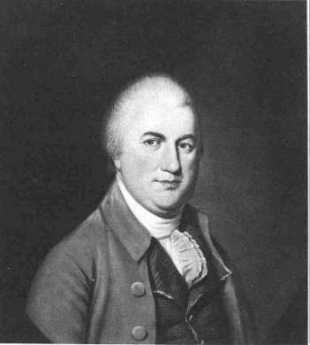
|
| Nathaniel Gorham |
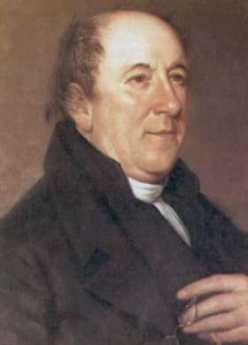
|
| Rufus King |
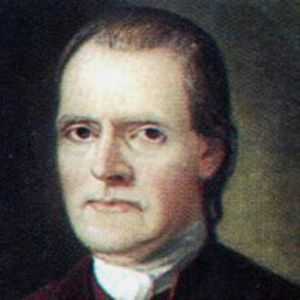
|
| Rodger Sherman |

|
| Alexander Hamilton |
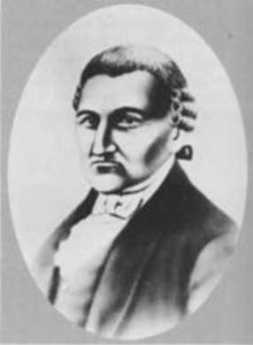
|
| David Brearly |
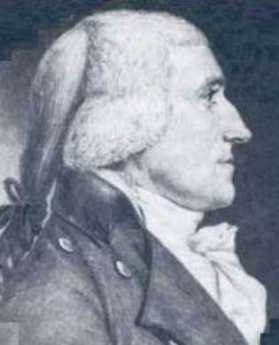
|
| Jonathan Dayton |
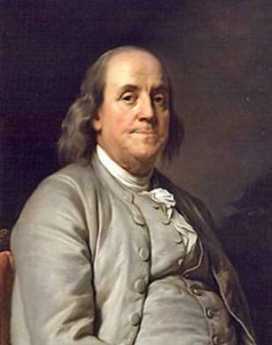
|
| Benjamin Franklin |
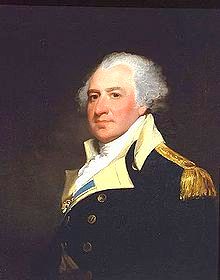
|
| Thomas Mifflin |
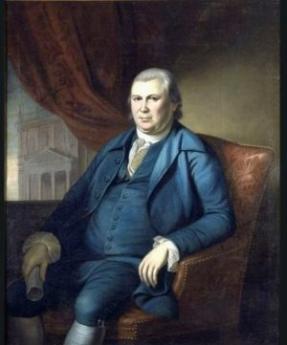
|
| Robert Morris |
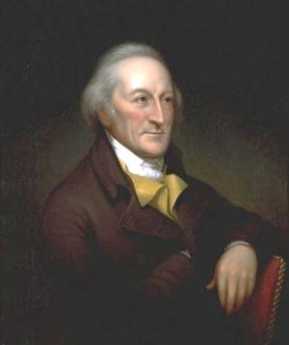
|
| George Clymer |
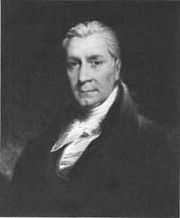
|
| Thomas Fitzsimons |
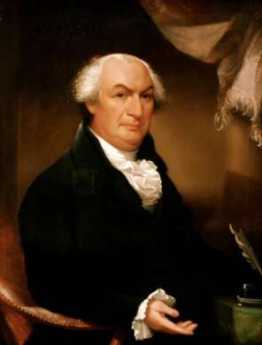
|
| Governor Morris |
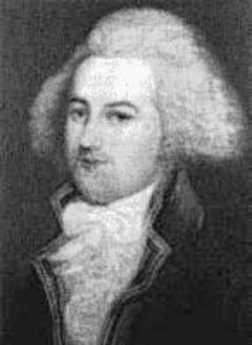
|
| William Houston |
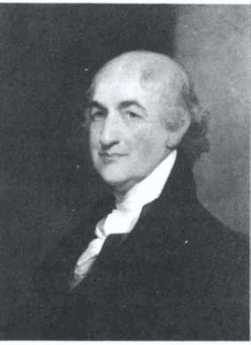
|
| Caleb Strong |
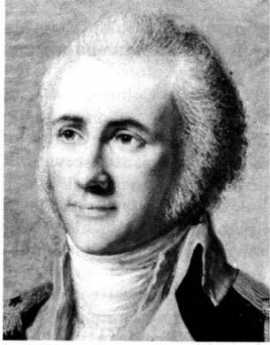
|
| William Davie |
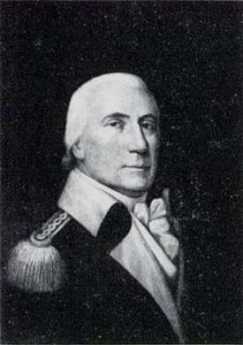
|
| Alexander Martin |
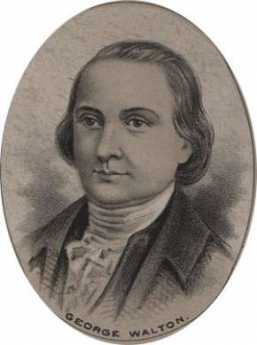
|
| George Walton |
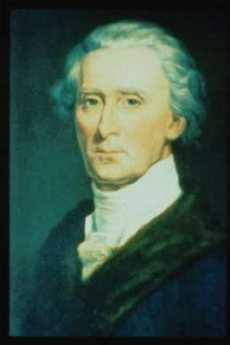
|
| Charles Carroll |
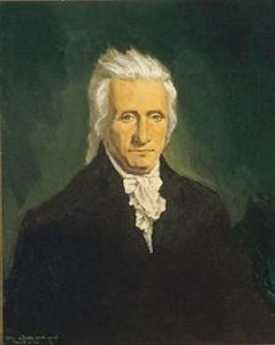
|
| Gabriel Duvall |
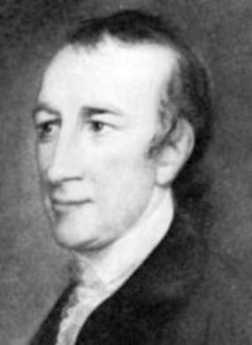
|
| Thomas Stone |
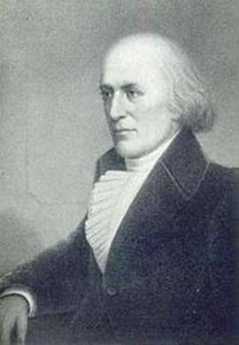
|
| Francis Dana |
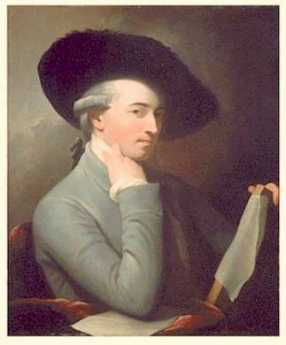
|
| Benjamin West |
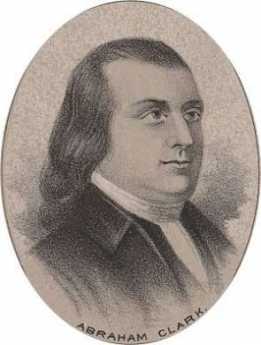
|
| Abraham Clark |
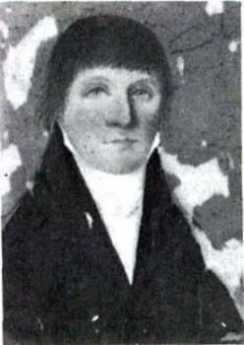
|
| Richard Caswell |
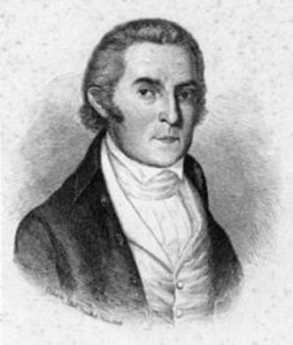
|
| Willie Jones |
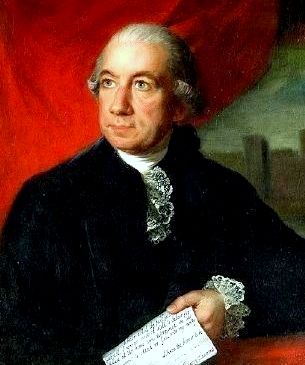
|
| Henry Laurens |
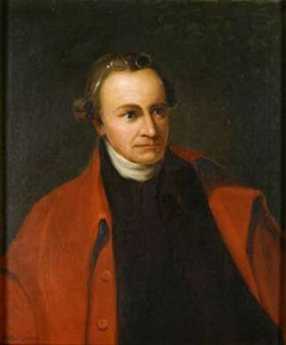
|
| Patrick Henry |
.jpg)
|
| Thomas Nelson |
The Schools of School House Lane

|
| Union School founded in 1759 |
The region of Philadelphia defined as Germantown is recorded by the last census as having about 50,000 inhabitants today, 40,000 of whom are of the black race. Germantown has always had an unusual concentration of schools of the highest quality, and here on one street alone there are four. School House Lane runs off to the West of Germantown Avenue, and was originally right at the center of town, the center of the action during the Revolutionary War. The most historic of the schools, the Union School founded in 1759, changed its name to Germantown Academy, and more recently picked up and moved to new quarters in Fort Washington. George Washington sent his nephew there, and its building served as a hospital for the wounded in the Battle of Germantown. When Germantown Academy moved out of Germantown, the Pennsylvania School for the Deaf moved into the vacated quarters. This school had been originally founded in 1820, and is one of nearly a hundred special schools for the deaf in the United States, operating as a quasi-public institution for about 170 students. A remarkable thing about all schools for the deaf is the high IQ of their students. Perhaps deaf underachievers are somehow filtered out by the struggle to adapt before they apply for admission, or perhaps there is something about being deaf that makes you smart. In any event, the average SAT scores of students from PSD, like all schools for the deaf, are always in the very highest ranks among secondary schools.
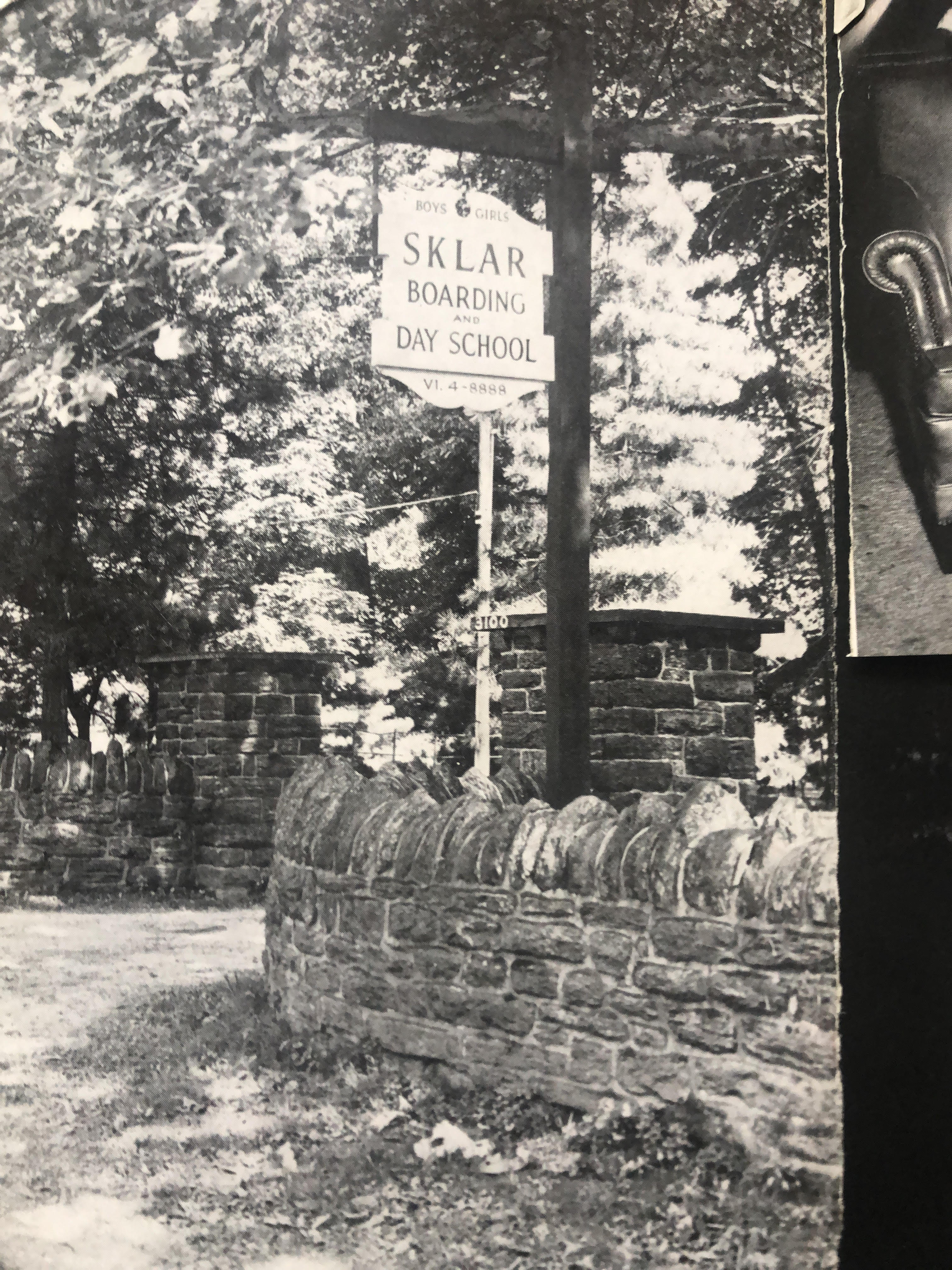
|
| Sklar School Entrance |
More or less next door to it, fronting on Coulter Street, is the Germantown Friends School(GFS), which enjoys and deserves the reputation of the most intellectually rigorous school in the Philadelphia region. There is little question about the Quakers of this school, founded in 1845, but relatively few of the students are now Quaker children. It's pretty expensive and quite uncompromising about its academic standards, but if you want to be accepted by a famous University, this is the place that can boast the most achievement of that variety. By no means all of its graduates become teachers, but alumni of this school do tend to gravitate to the top of academia. That could eventually put them on college admission committees, of course, and perhaps the admission process promotes itself. There can be little doubt that if most of a given college's admission committee happened to play the tuba, that university would soon fill up with tuba players.
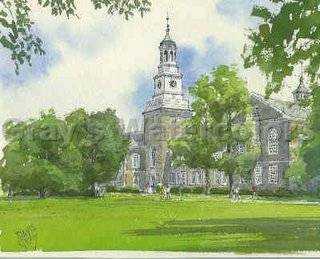
|
| William Penn Charter School |
Further West on School House Lane, is the William Penn Charter School. It's also Quaker, and while it doesn't work quite so hard at it as GFS does, it has plenty of social mission, a great deal more discipline, and plenty of competitive athletics. A minority of its students, also, are Quakers; but as a guess, most of its graduates are headed for disproportionate affluence anyway. The middle school is named for, and was donated by, the former chairman of Morgan Stanley back before Morgan Stanley sold itself to Dean Witter. This school was founded in 1689, and for a long time was located at 12th and Market Streets in Philadelphia, right where the famous PSFS building was built, the one that later converted to Lowe's Hotel .
Finally, near the crossing of Henry Avenue with Schoolhouse Lane, is the Philadelphia University. Since it was founded in 1999 it is the youngest of the schools on School House Lane, specializing in architecture and design, and seems headed for even broader curriculum. The University was formed by the merger of Ravenhill Academy for Girls, and the Philadelphia Textile School. The Textile School was itself formed during the 1876 Philadelphia Centennial, when local industrialists became concerned with how backward America seemed in its quality and design of textiles, compared with other nations which exhibited at that World's Fair. Next door, was once the home of William Weightman, a chemical manufacturer who was reputed to be the richest man in Pennsylvania. After his death, the rather grand estate became the site of the Ravenhill School for Girls, which was the school which could boast Grace Kelly for an alumna. That was natural enough since she lived just around the corner on Henry Avenue and could walk to school. The contrast between the two ends of School House Lane, Henry Avenue on one end, and Germantown Avenue on the other, is just astounding.
So there you have School House Lane. A few short blocks with three distinguished preparatory schools and a university. Plus, the site of three other famous schools which have either moved or merged. You might think Germantown was the home of myriads of school teachers, but that isn't exactly so. It's hard to say just what this complex anomalous situation proves, except to voice the opinion that it is somehow at the heart of what Philadelphia really is.
Note, kind readers have also sent me the names of six more schools on Schoolhouse Lane. Some of them may only be name changes, but the list includes Parkway Day School, Sklar School, Philadelphia Textile and Science, Germantown Stevens Academy, Germantown Lutheran Academy, Greene Street Friends School. (See Comments.)
For the Good of the Order
Although it has older origins, Roberts Rules of Order provide a place in every meeting for remarks "for the good of the order", suggesting there should always be an opportunity to deviate from strict germaneness to speak about something which is clearly worth talking about. Although meetings for business usually appoint a chairman, speaker or clerk to preserve order and germaneness, the truth is that most meetings which lose the opportunity to introduce something worthwhile which is a little off the subject, do so because of habit and tradition rather than devotion to focus. In recent years, remarks for the good of the Order have become so uncommon that speakers tend to rise on "a point of personal privilege", although provision for this had in mind birthday greetings and the like.
I suggest it might be a useful and entertaining thing to devote some meetings of the Franklin Inn to discussions of ways we could improve the club, and if the club has seemingly already reached perfection, to ways of improving Philadelphia and its Commonwealth.
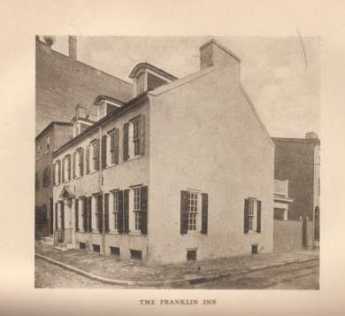
|
| The Franklin Inn |
Such an effort will struggle at first, so it needs a core group to assure hesitating attendees that something worthwhile will be said. That core group may include officers and officials who are charged with running the club, the city or the state, but the opinions of the meeting should carry no enforcement powers other than their intrinsic validity. Admittedly, there is a natural restlessness of independent thinkers that their ideas should go somewhere, so the meetings should maintain minutes, perhaps on a website.
The attendees should pay for their lunches with meal tickets, but should also maintain a book of tickets for invited guests, and sell tickets to uninvited ones. If the present markup for tickets is maintained, an attendance of six regulars would sustain the invited speaker ticket book, and the attendance of six uninvited (no-club members) would make subsidy unnecessary. For the initial year, however, the club itself should subsidize speaker lunches. If there are conflicting meetings the Meetings for the Good of the Order should move to the second floor, and perhaps that is the best place for all of them.
These meetings should not fall into the trap of grieving that their innovative suggestions are not adopted, although they may be forgiven for celebrating the occasions where an idea does get implemented. The goal is to help an idea grow legs, and then watch it travel, ever mindful that much can be accomplished when we disregard who gets credit for it.
SEPTA's Long Term Planning
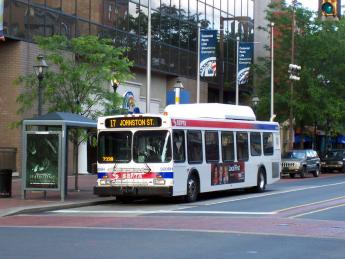
|
| Septa |
Byron S. Comati, the Director of Strategic Planning and Analysis for SEPTA (Southeastern Pennsylvania Transportation Authority), kindly gave the Right Angle Club an inside look at the hopes and plans of SEPTA for the near (five-year) future. Students of large organizations favor a five or six-year planning cycle as both short enough to be realistic, and long enough to expect to see tangible response. If plans continuously readjust to fit the five-year horizon, the concept is that the organization will move forward on these stepping stones, even accounting for setbacks, disappointments, and surprises. Furthermore, a serious level of continuous planning puts an organization in a position to react when funding opportunities arise, such as the sudden demand of the Obama Administration that economic stimulus proposals be "shovel ready."

|
| The Silverline V |
So, SEPTA is currently promoting five major expansions, based on the emerging success of an earlier plan, the Silverliner V. Silverline is a set of 120 shiny new cars, built in Korea on the model of electrical multiple units, which are expected in Spring 2011 to replace 73 cars or units which were built in 1963. Obviously, 120 are more expensive than 73, but they are more flexible as well. And less wasteful; most commuters are familiar with the model of three seats abreast which unfortunately conflict with the social preferences of the public, tending to make the car seem crowded even though it is a third empty. When a misjudgment like this is made, it takes fifty years to replace it with something better. For example, there's currently a movement toward "Green construction", which is acknowledged to be "a little bit more expensive". The actual costs and savings of green construction have yet to become firmly agreed on, so there's an advantage to being conservative about what's new and trendy in things that take fifty years to wear out.

|
| Septa Regional Map |
Four of SEPTA's five major proposed projects are in the Pennsylvania suburbs. New Jersey has its own transportation authority, and Philadelphia is thus left to struggle with the much higher costs of urban reconstruction assigned to its declining industrial population. And left unmentioned is the six hundred pound gorilla of the transportation costs of new casinos. A great many people are violently opposed to legalized gambling, and even more upset by the idea of crime emerging in the neighborhoods of gambling enterprises. Even the politicians who enacted this legislation are uncomfortable to see the rather large expenditures which will eat into the net revenue from this development. Nevertheless, if you are running a transportation system, you have an obligation to plan for every large shift in transportation patterns, no matter what you might think of the wisdom of the venture. The alternative is to face an inevitable storm of criticism if casinos come about, but without any preparation having been made for the transportation consequences. At present, the public transportation plan for the casinos is to organize a light rail line along the Delaware waterfront, connecting to the rest of the city through a spur line west up Market Street; it may go to 30th Street Station, or it may stop at City Hall. That sounds a lot like the present Market-Frankford line, so expect some resistance when the cost estimates are revealed. Because all merchants want to have the station stops near them, and almost no residents want a lot of casino foot-traffic near their homes and schools, expect an outcry from those directions, as well. It would be nice to integrate this activity with something which would revive the river wards, but it seems a long stretch to connect with Wilmington on the south, or Trenton on the north.
The planned expansions in the suburban Pennsylvania counties will probably encounter less controversy, although it is the sorry fate of all transportation officials to endure some hostility and criticism for any changes whatever. Generally speaking, the four extensions follow a similar pattern of building along old or abandoned rail lines, following rather than leading the population migrations of the past. When you are organizing mass transit, there is a need to foresee with some certainty that there will be a net increase in commuters in the region under consideration. The one and two passenger automobile is a much more flexible instrument for adjusting to the growth of new development, schools, retail, and industry. Once the region has become established, there is room for an argument that transportation in larger bulk is cheaper, cleaner or whatever.
The Norristown extension follows the existing but underused rail connections to Reading. Route US 422 opened up the region formerly serving the anthracite industry, but now the clamor is rising that US 422 is impossibly crowded and needs to be supplemented with mass transit.
The Quakertown extension follows the rail route abandoned in 1980 to Bethlehem and Allentown, although the extension is only planned as far as Shelly, PA.
The Norristown high-speed extension responds to the almost total lack of public transportation to the King of Prussia shopping center, and will possibly replace the light rail connection to downtown Philadelphia.
And the Paoli extension follows the mainline Amtrak rails as far as Coatesville.
All of these expansions can expect to be greeted with huzzahs by developers, land speculators, and newsmedia, but resistance will inevitably be as fierce as it always is. Local business always fears an expansion of its competitors; the feeling is stronger in the suburbs than the city, but local business always resists and local politicians always follow their lead. To some extent, the suburbs have a point, since radial extensions are usually much cheaper to build than lateral or circumferential transportation media; bus routes are the favored pioneers in connecting one suburb with another. Therefore, the tendency in these present plans remains typical by threatening the suburbs with a need to travel toward the center hub, then take a reverse branch back in the general direction of where they started, in order to go a short distance to a shopping center or school system. The two main river systems around Philadelphia interfere with the construction of big "X" routes from the far distance in one direction to the far distance in the opposite direction. Euclidian geometry makes the circumferential route elongate as the square of the radius. And jealousies between the politicians in three states create rally foci for the special local interests which feel injured. Since it seems to be an established fact that the proportional contribution to mass transportation by the surrounding suburbs of Philadelphia is traditionally (and considerably) lower than the national average, a political reconciliation might do more for the finances of SEPTA than any federal stimulus package could do. For such reconciliation, a few lateral connections in the net might pacify the suburbs enough to justify the extra cost. Unfortunately, the main source of unjustified cost in regional mass transit is the high wage and benefit levels of the employees, a situation inherited from the old days when commuter rail was part of the stockholder-owned regional railroads. Just as featherbedding was the main cause of the destruction of the mainline railroads, health and pension benefits threaten the life of mass transit. In the old days, local governments acted as a megaphone for union demands. So the railroads just gave the commuter system to the local governments, and let them wrestle with the unions themselves. Since the survival of the urban region depends on conquering this financial drain, the problem must be gradually worn down. But it has been remarkable how long the region has been willing to flirt with bankruptcy rather than bite this bullet.
If anything, this friction threatens to get worse. In 2009, for the first time, a majority of union members in America -- work for the government, the one industry which thinks it cannot be destroyed by losing money. True, SEPTA is not exactly a government function, but it has enough in common with a government department to arouse suburban voters, who regularly refer to it as an arm of the urban political machine. SEPTA isn't too big to fail, but there exists little doubt that government at some level would probably try to bail it out if it did.
Funny Toes: A Physician Viewpoint

|
| Webbed Toes |
It probably took me twenty years to notice that, unlike most people, I had an incomplete separation of my second and third toes. I thought my toes were like everybody else's, but once you start peeking, you see that webbed toes are not normal, although they are not really rare, either. After another thirty years, it became apparent that most of my numerous descendants had the same kind of toe; it was obviously an inherited condition. When the family clan gathered at the beach, it was a source of mild amusement, possibly even a little pride. A few weeks ago, I happened to mention the matter at a party, whereupon another doctor promptly pulled off his shoes and socks, and revealed fused or webbed toes of a much more striking sort than mine; obviously, he was proud of it, too. He is of an old, old Philadelphia family that owns one of the oldest, if not the oldest, a house in Germantown. His family, too, is stigmatized in the same way only more so. In Philadelphia, when you are proud of your family, you are really, really, proud of it.
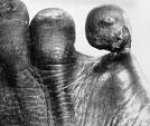
|
| Ainhum |
Which brings me back to my days as an intern in the accident room of the Pennsylvania Hospital. When there is a sudden crowd of emergencies in an emergency department, the nurses get all of them undressed, put in a hospital gown, and instructed to wait for the doctor behind a curtain that doesn't quite reach the floor. For some reason, as a medical student, I had been particularly struck by a photograph in a textbook of an inherited disorder said to have been first noted on a slave ship; the disease in the native language was named Ainhum. For reasons obscure, a tight little band appears at the base of the fifth, or little, too. It gets slowly tighter over a period of months, and eventually, the little toe falls off. That's all there is to Aihnum, and all that was known about it. So, imagine my surprise and delight to walk past a row of naked feet sticking out below curtains -- and there was my first and last case of Aihnum.
I summoned my colleagues, and the visiting medical students from both Jefferson and Penn who at that time shared training in our accident room. I raced off to my room to get a camera to record this momentous event. An elderly staff physician, either Tom McMillan or Charles Hatfield, wandered past and was invited to share the excitement. Well, he says, I saw one of those forty years ago, it looked just like that; old Doctor Norris showed it to me when I was an intern. Much murmuring ensued but abruptly stopped when the patient himself rose up and started putting on his clothes. He was going home, but why? "Well," he growled, "I came here because my back hurts, and all you people do is look at my toes!" He said he was going over to the Jefferson Hospital to get proper treatment, and I guess he did.
And finally, there is Morton's Toe. Or perhaps more properly, Mortons' Toes. There were in fact two Doctor Mortons, one of them at Columbia College of Physicians and Surgeons where I went to school, and the other at the Pennsylvania Hospital where I interned. In New York, Morton's Toe refers to a painful callous, or neuroma, that forms on the bottom of the victim's big toe. In Philadelphia, such an answer would get a failing grade, because the Philadelphia Morton had noticed that some people have a big toe that is shorter than the other toes, instead of being bigger as the term would suggest was proper. The tricky thing about this relatively harmless variant is that the big toe is actually not short at all. The foot bone, or metatarsal, is short, so the toe of normal length sits back farther on the foot and just looks shorter. The main significance is for shoe salesmen since the shoe needs to be long enough to avoid crushing the other toes.
So now, you readers who were not lucky enough to go to medical school can get a feeling for what it seems like to be a doctor. The other significant shared bond within the fraternity is a sense of outrage at the way health insurance companies drag their feet paying doctors, but that's not limited to feet..
What Happened in Philadelphia on July 4, 1776?
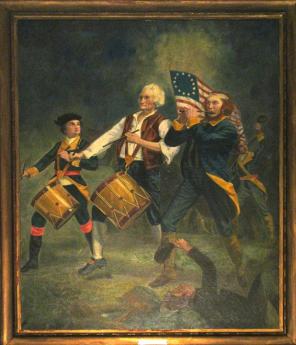
|
| Spirit of 76' |
The American colonies were growing too big, too fast, and the British Empire had too many international distractions, to have smooth relationships across three thousand miles of ocean, using uncertain communications available in the late Eighteenth century. Friction and misunderstanding were inevitable without far more statesmanship than either side thought was necessary. So, when the Continental Congress dispatched George Washington to Boston with troops to defend rebellious Massachusetts at Lexington, Concord, and Bunker Hill, it was hard for the British to believe the colonists were merely helping out one of their distressed neighbors. It seemed in London that the thirteen colonies had united, formed not only an army but a government, and gone to war. In December 1775 England passed the Prohibitory Act, essentially declaring war, and organized a huge invasion fleet to put down the rebellion. It now seems hard to understand the first notice the Americans had of this huge over-reaction was a private letter to Robert Morris from one of his agents in March 1776; no warnings, no negotiations, no attempt to investigate problems and correct them. The British just sent a fleet to settle this problem, whatever it was. It's all very well to say the Americans should have known they were playing with fire. They didn't see it that way; they were being self-reliant, responding to attack. In June 1776 British patrol frigates were skirmishing in the Delaware River; late in the month, British troops landed on Staten Island. The American reaction to all this was a muddle of confusion. A few were delighted, most of the rest were amazed or appalled.
Although the deeper strategic origins of the American Revolution are subtle, complex, and controversial, there is far less muddle about what happened on July 2, 1776, publicly proclaimed two days later. Adopting a resolution written by Richard Henry Lee of Virginia, the Thirteen Colonies stated they had now clarified their goals in the controversy with the British monarchy. For a year before that, the Continental Congress had been corresponding with each other and meeting in Carpenters Hall with the goal of achieving representation in the British parliament -- "No taxation without representation". The model for most of them was based on the Whig agitation for Ireland -- for a local parliament within a larger commonwealth. But the passing of the British Navy in Halifax, Nova Scotia, and then the actual appearance of seven hundred British warships in American waters showed that not only was Parliamentary representation out of the question, but King George III was going to play rough with upstarts. The new goal was no longer just representation, it was independence. If we were going to resist a military occupation at the risk of being hanged as traitors, we might as well do it for something substantial. The meeting had a number of Scotch-Irish Princeton graduates, whose basic loyalty to England had long been divided. Pacifist Pennsylvania, chief among the wavering hold-outs, was mostly won over by its own Benjamin Franklin, who was optimistic the French would help us. Even so, both Robert Morris and John Dickinson refused to sign the Declaration; Franklin persuaded both to abstain by absence, which created a majority of the Pennsylvania delegation in favor. That's a pretty slim majority for a crucial decision. Franklin was soon dispatched back to Paris to make an alliance; Washington was dispatched to hold off that British army in the meantime. Jefferson was designated to write a proclamation, which even after editing is still pretty unreadable beyond the first couple of sentences. Meeting adjourned. This brief account may not qualify as a serious examination of the causes of the American Revolution, but it comes close to the way it seemed to the colonist in the street.
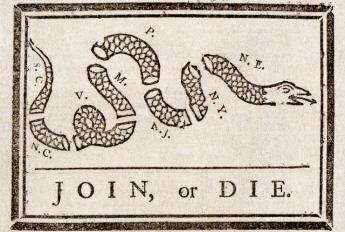
|
| Colonist's Complaint |
The rebels then spent eight years convincing the British they were serious and have been independent ever since. But, just a minute, here. Reflect on the fact that fighting had been going on for a year in Massachusetts, and that Lord Howe's fleet had set sail a month before the Declaration, actually landing on Staten Island at just about the same time as the Fourth of July. Add the fact that only John Hancock actually signed the document on July 4th, and some of the signers even waited until September. You can sort of see why John Adams never got over the idea that Thomas Jefferson had a big nerve implying the whole Revolution was his idea. What's more, there's a viewpoint that New England subsequently had to endure a President from Virginia for thirty-two of the first thirty-six years of the new nation because loud talk from New England still made the rest of the country nervous. Philadelphia may have been the cradle of Independence, but that was not because it was a colony hot for war, dragging others along with it. Rather, it was the largest city in the colonies, centrally located. It had a strong pacifist tradition, and it had the most to lose from a pillaging enemy war machine. When Independence was finally declared the goal, many of Philadelphia's leading citizens moved to Canada.
New England had started hostilities and was about to be subdued by overwhelming force. The Canadians were not going to come to their aid, because they were French, and Catholic, and enough said. What New England and the Scotch-Irish needed were WASP allies, stretching for two thousand miles to the South. By far the largest colony was Virginia, which included what is now Kentucky and West Virginia; it even had some legal claims for vastly larger territory. Virginia was incensed about its powerlessness against British mercantilism, especially the tobacco trade. The rest of the English colonies had plenty of assorted grievances against George III, and almost all of them could see that America was rapidly outgrowing dependency on the British homeland, without a sign that Parliament was ever going to surrender home rule to them. It was perhaps unfortunate New Englanders were so impulsive, but it looked as though a military confrontation with the Crown was inevitably coming. Without support, New England was likely to be torched, as Rome once subdued Carthage.
And the last hope for an alternative of flattery and diplomacy, for guile and subtlety, had stepped off the boat a year earlier. Benjamin Franklin, our fabulous man in London, arrived with the news he had finally had it "up to here" with the British ministry. He was a man who quietly made things happen, carefully selecting his arguments from amongst many he had in mind. In retrospect, we can see that he held the idea of Anglo-Saxon world domination as far back as the Albany Conference of 1745, and could even look forward to America outgrowing England in the 19th Century. His behavior at the Constitutional Convention of 1787 strongly suggests he never completely gave up that long-term dream. Just as Edmund Burke never gave up the idea of Reconciliation with the Colonies, Benjamin Franklin never quite gave up the idea of Reconciliation with England. While John Dickinson and Robert Morris resisted the idea of Independence down to the last moment, Franklin took a much longer view. For the time being, it was necessary to defeat the British, and for that, we needed the help of the French. In 1750, America joined with the British to toss out the French. And then in 1776, we joined the French to toss out the British. Franklin didn't always get his way. But Franklin was always steering the ship.
Northwest Ordinance of July 13, 1787: Articles of Confederation at their Best
COMING across the term "Northwest Territory" for the first time, modern students can easily confuse it with the states of Washington and Oregon, more precisely called the Pacific Northwest, thousands of miles to the west. The United States acquired this more eastern Territory from the British -- bounded on the south by the Ohio and Mississippi Rivers below Canada, and West of the Appalachian Mountains -- at the second Treaty of Paris which ended the Revolutionary War in 1783. Before that, the British had acquired it from the French at the first Treaty of Paris, ending the French and Indian War in 1763. Until the Louisiana Purchase in 1803, this land really was the Northwestern tip of American possession, even though it is less than half-way between the Atlantic and Pacific Oceans. It was occupied by Indian tribes who much preferred dealing with wandering British fur traders, to the new threat of permanent occupation by American settler families. In part, bloody warfare with the Shawnee Indians under Tecumseh did somewhat justify the reluctance of the British to give up their chain of forts in Indian Territory friendly to them, but rapid immigration to America from Europe after the end of the war soon generated great westward pressure for settlers to move there. In general, these new immigrants were neither military veterans nor experienced woodsmen and suffered several large massacres from Indians whose homelands were threatened. The Northwest Territory was a dangerous place for unseasoned settlers at the end of the Eighteenth century.
Consequently, it required four years for the new Republic to decide how to handle this sudden expansion of territory it must govern. The question of excluding slavery had already come up, along with the puzzle of managing the masses of raw European immigrants as they encountered and outraged the native Indians. Furthermore, a military alliance, which is what the Articles of Confederation amounted to, is an awkward vehicle for governing an expanding frontier wilderness, especially while it was experimenting with new forms of governance. For one thing, joint ownership by thirteen sovereignties seemed almost certain to tempt one or two of them to take it all over, provoking interstate war and possibly endless disputes between former friends. Most observers in retrospect regard the Northwest Ordinance of the Confederation Congress to be a sensible and workable product, which happened to be just about the last major act of that political body. The Constitutional Convention overlapped it.
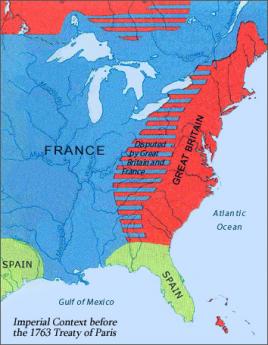
|
| Before the French and Indian War. |
The Ordinance under the Articles of Confederation was ratified on July 13, 1787, whereas the Constitutional Convention was in session from May 14 to September 17, 1787. No doubt a smooth transition between the two was under discussion, although the Confederation Congress was an itinerant body, always struggling to produce a quorum and a place to meet. Judging from their behavior after the Constitution was ratified, some undefined proportion of the Confederation Congress may have continued to harbor States Rights resentments at being displaced by a new nationalist government. At the very least, it would only be natural for some of the Congress to be offended that Washington failed to endorse them for the Constitutional Convention. Following that, the advocates of Constitutional ratification were then fairly careless in denouncing the inadequacy of the Articles by citing the failures of the Confederation Congress as examples of it.
The Northwest Ordinance provided for a military government until a civilian one could establish itself. Conquering armies are quite accustomed to the rough uncertainties of keeping a hostile territory subdued while a declared enemy is relentlessly dealt with under a different set of rules. The Congress (soon amended to substitute the President) was to appoint temporary governors and panels of judges. A provisional civilian government was added as soon as five thousand male settlers (each owning fifty acres of land) were resident, and that provisional government was to help devise a state constitution and set of laws as soon as sixty thousand such settlers were resident. The Ordinance allowed the territory to be divided between three to five states, but the borders of five states were laid out from the start. At first, this discordance between laying out the inflexible boundaries for five states, and at the same time allowing for a variable number of states, seems careless to later generations. But the Congress had no idea how fast different states would fill with settlers but assumed it was likely it would fill from East to West. They thus laid out the ghost outlines of five states within the territory, detaching statehoods as the minimum population filled them up.
A carefully planned, three-step progression (from the military, to provisional, to statehood) turned out to be an excellent expedient for managing other new states created by an expanding frontier throughout the Nineteenth century. Those who today complain that the bicameral Legislative branch is implausible, are not merely disregarding the vital need at the Constitutional Convention for a compromise between the large and small states in a Union of three big with ten small. They must also recognize that the frontier would probably expand by acquiring lightly inhabited land and breaking it up into states, followed by immigration from the edges. Many states were destined to begin with small populations, and grow to have big ones. To maintain strict adherence to population limits for new states would probably result in peculiarly-shaped, but densely populated, states on the edges, possibly in large numbers, along with endless quarrels about suspected gerrymandering of the Senate. It may not be an accident that Elbridge Gerry, the namesake of Gerrymandering, was on the committee devising this Ordnance. The U.S. Senate has long been proud of its immunity to gerrymandering, contrasted with the evils the process regularly imposes on the House of Representatives. The Great Compromise of a bicameral legislature, giving equal Senate power to many small states, but House of Representative power to a few big ones, was only weeks from being struck; there may be some connection, here. Although the balance continually shifts, the generalization is still true that America is a Union of a few big states and many small ones. Seemingly, the election rules are not likely to change substantially. Eliminating the Electoral College, much grumbled by the big states is thus also, forever unlikely.

|
| The Varsity Comes Onto the Field |
It seems useful to point out the practical utility of defining citizens who "live" in a district, as being those who probably own land there. The Northwest Territory was a vast expanse of wilderness, much of which soon become the most valuable farmland in the world, with topsoil two feet thick. The rules of this land rush were that it was to be governed by Federal troops until there were five thousand male settlers, presumably the minimum sufficient to defend against hostile Indians. However, the assumption of political power, along with its ability to set the rules, offered a temptation to find ways of making the number unreasonably easy to reach or temporarily composed of a particular political group. Demanding that eligible citizens must each own a liveable plot of farmland probably seemed wise precaution against carpet-bag "voters" being temporarily imported for the voting. A similar provision was soon included in the Constitution, although that is often held up by partisan writers as proof of aristocratic leanings among the Constitutional Framers. With land selling for fifteen cents an acre, it seems more likely it was a practical test of genuine residence, the Eighteenth century equivalent of presenting a driver's license as identification at the polling booth. In both instances, those suspected of impersonating local voters pretend to the great offense at the voicing of any suspicion of it.
The Northwest Territory eventually became Ohio, Indiana, Illinois, Michigan, and Wisconsin, plus a part of Minnesota. The dynamics of migration took unexpected turns. Although Ohio was the seventeenth state, admitted in 1803, Wisconsin was the thirtieth, waiting until 1848 for admission to statehood. For a while, a settlement was more rapidly toward the South, and near the region of the Louisiana Purchase. The Northwest Ordinance was in force without major amendment for almost fifty years.
Part of its durability can be traced to the prohibition of slavery in the Northwest Territory. The existing Southern states were remarkably peaceful about agreeing to slavery prohibition, a reaction said to arise from tobacco growing southern states indifferent to competition to their main crop, from areas with presumably higher labor costs. When the main crop soon turned from tobacco to cotton, the anti-competitive argument apparently had less force. One cannot contemplate the horrendous impending casualties of the Civil War without wondering if massaging of the competition argument might have been put to more imaginative use during the forty-year interval of free soil agitations. Unfortunately, since politicians did not appreciate the price they were about to pay for a policy of drift, they obstructed the (probably) much smaller costs of facing the issue sooner.
Political Parties, Absent and Unmentionable
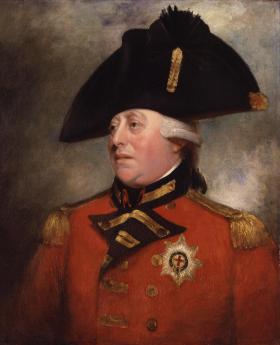
|
| King George III |
BECAUSE America had recently revolted to rid itself of King George III, the Constitutional framers of 1787 sought to construct a government forever free from one-man rule. Inefficiency could be accepted but central dictatorial power, never. It is unrealistic however to expect a wind-up toy to keep working forever, and our Constitution creates the same worry. After two centuries, some chinks have appeared.
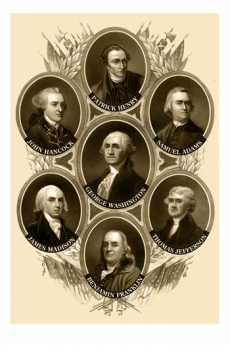
|
| Founding Fathers |
Political parties existed in 18th Century England and Europe, but the American founding fathers seem not to have worried about them much. Within ten years of Constitutional ratification, however, Thomas Jefferson had created a really partisan party which naturally provoked the creation of its partisan opposite. James Madison was slowly won over to the idea this was inevitable, but George Washington never budged. Although they were once firm friends, when Madison's partisan position became clear to him, Washington essentially never spoke to him again. Andrew Jackson, with the guidance of Martin van Buren, carried the partisan idea much further toward its modern characteristics, but it was the two Roosevelts who most fully tested the U.S. Supreme Court's tolerance for concentrating new powers in the Presidency, and Obama who recognized that the quickest way to strengthen the Presidency was to weaken the Legislative branch.
Dramatic episodes of this history are not central to present concerns, which focuses more on the largely unnoticed accumulations of small changes which bring us to our present position. Wars and economic crises induced several presidents, nearly as many Republicans as Democrats, to encourage migrations of power advantage which never quite returned to baseline after each crisis. Primary among these migrations was the erosion of the original assumption of perfect equality among individual members of Congress. A new member of Congress today may tell his constituents he will represent them ably, but when he arrives for work he is figuratively given an office in the basement and allowed to sit on empty packing cases. This is not accidental; the slights are intentional warnings from the true masters of power to bumptious new egotists, they will get nothing in their new environment unless they earn it. Not a bad idea? This schoolyard bullying is a very bad idea. If your elected representative is less powerful, you are less powerful.
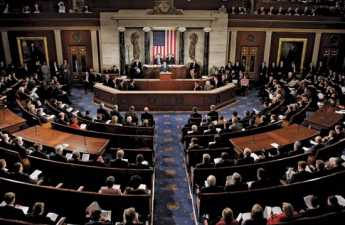
|
| Houses of Congress |
Partisan politics begins with vote-swapping, evolves into a system of concentrating the votes of the members into the hands of party leaders, and ultimately creates the potential for declaring betrayal if the member votes his own mind in defiance of the leader. The rules of the "body" are adopted within moments of the first opening gavel, but they took centuries to evolve and will only significantly change direction on those few occasions when newcomers overpower the old-timers, and only then if some rebel among the old timers takes the considerable trouble to help organize them. In the vast majority of cases, after adoption, the opportunity to change the rules is then effectively lost for two years. Even the Senate, with six-year staggered terms, has argued that it is a "continuing body" and need not reconsider its rules except in the face of a serious uprising on some particular point. Both houses of Congress place great weight on seniority, for the very good purpose of training unfamiliar newcomers in obscure topics, and for the very bad purpose of concentrating power in "safe" districts where party leaders are able to exercise iron control of the nominating process. Those invisible bosses back home in the district, able to control nominations in safe districts, are the real powers in Congress. They indirectly control the offices and chairmanships which accumulate seniority in Congress; anyone who desires to control Congress must control the local political bosses, few of whom ever stand for election to any office if they can avoid it. In most states, the number of safe districts is a function of controlling the gerrymandering process, which takes place every ten years after a census. Therefore, in most states, it is possible to predict the politics of the whole state for a decade, by merely knowing the outcome of the redistricting. The rules for selecting members of the redistricting committee in the state legislatures are quite arcane and almost unbelievably subtle. An inquiring newsman who tries to compile a fifty-state table of the redistricting rules would spend several months doing it, and miss the essential points in a significant number of cases. The newspapers who attempt to pry out the facts of gerrymandering are easily gulled into the misleading belief that a good district is one which is round and compact, leading to a front-page picture showing all districts to be the same physical size. In fact, a good district is one where both parties have a reasonable chance to win, depending for a change, on the quality of their nominee.
So that's how the "Will of Congress" is supposed to work, but the process recently has been far less commendable, and in fact, calls into dispute the whole idea of a balance of power between the three branches of government. We here concentrate on the Health Reform Bill ("Obamacare") and the Financial Reform Bill ("Dodd-Frank"), which send the same procedural message even though they differ widely in their central topic. At the moment, neither of these important pieces of legislation has been fully subject to judicial review, so the U.S. Supreme Court has not yet encumbered itself with stare decisis of its own creation.
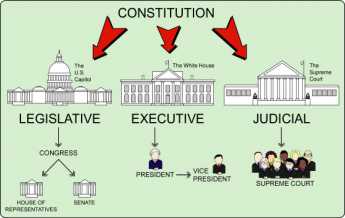
|
| Three branches of government |
In both cases, bills of several thousand pages each were first written by persons who if not unknown, are largely unidentified. It is thus not yet possible to determine whether the authors were affiliated with the Executive Branch or the Legislative one; it is not even possible to be sure they were either elected or appointed to their positions. From all appearances, however, they met and organized their work fairly exclusively within the oversight of the Executive Branch. Some weighty members of the majority party in Congress must have had some involvement, but it seems a near certainty that no members of the minority party were included, and even comparatively few members of highly contested districts, the so-called "Blue Dogs" of the majority party. It seems safe to conjecture that a substantial number either represent special interest affiliates or else party faithful from safe districts with seniority. The construction of the massive legislation was conducted in such secrecy that even the sympathetic members of the press were excluded, and it would not be surprising to learn that no person alive had read the whole bill carefully before it was "sent" to Congress. It's fair to surmise that no member of Congress except a few limited members of the power elite of the majority party were allowed to read more than scattered fragments of the pending legislation in time to make meaningful changes.
The next step was probably more carefully managed. No matter who wrote it or what it said, a majority of the relevant committees of both houses of Congress had to sign their names as responsible for approving it. Because of the relatively new phenomenon of live national televising of committee procedure, the nation was treated to the sight of congressmen of both parties howling that they were only given a single day to read several thousand pages of previously secret material -- before being forced to sign approval of it by application of unmentioned pressures enabled by the rules of "the body". When party members in contested districts protested that they would be dis-elected for doing so, it does not take much imagination to surmise that they were offered various appointive offices within the bureaucracy as a consolation. As it turned out, the legislation was only passed narrowly on a straight-party vote, so there can be a considerable possibility of its likely failure if the corruptions of politics had been set aside, with members voting on the merits. Nevertheless, since this degree of political hammering did result in a straight-party vote, it leaves the minority party free to overturn the legislation when it can. The prospect of preventing an overturn in succeeding congresses seems to be premised on "fixing" flaws in the legislation through the issuance of regulations before elections can open the way to overturn of the underlying authorization. Legislative overturn, however, is very likely to encounter filibuster in the Senate, which presently requires 40 votes. Even that conventional pathway is booby-trapped in the case of the Dodd-Frank Law. The Economist magazine of London assigned a reporter to read the entire act, and relates that almost every page of it mandates that the Executive Branch ("The Secretary shall") must take rather vague instructions to write regulations five or ten times as long as the Congressional authorization, giving the specifics of the law. The prospect looms of vast numbers of regulations with the force of law but written by the executive branch, emerging long after the Supreme Court considers the central points, years after the authorizing congressmen have had a chance to read it, and well after the public has rendered final judgment with a presidential election. The underlying principle of this legislation is the hope that it will later seem too disruptive to change a law, even though most of it was never considered by the public or its representatives.
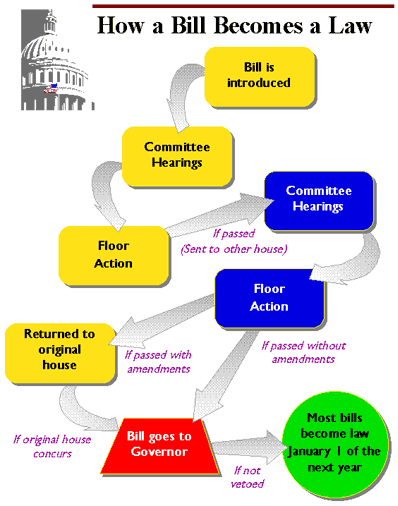
|
| Bill become a Law |
The "regulatory process" takes place entirely within the Executive branch. Congress passes what it terms "enabling" legislation, containing language to the effect that the Cabinet Secretary shall investigate as needed, decide as needed, and implement as needed, such regulations as shall be needed to carry out the "Will" of Congress. Since the regulations for two-thousand-page bills will almost certainly run to twenty thousand pages of regulations with the force of law, the enabling committee of Congress will be confronted with an impossible task of oversight, and thus will offer few objections. The Appropriations Committees of Congress, on the other hand, are charged with reviewing every government program every year and have the power to throttle what they disapprove of, by the simple mechanism of cutting off the program's funds. Members of the coveted Appropriations Committees are appointed by seniority, come from safe districts, and are attracted to the work by the associated ability to bestow plums on their home districts. By the nature of their appointment process, unworried by the folks back home but entirely beholden to the party bosses, they have the latitude to throttle anything the leadership of their party wants to throttle badly enough. The outcome of such take-no-prisoners warfare is not likely to improve the welfare of the nation, and therefore it is rare that partisan politics are allowed to go so far.
The three branches of government have become unbalanced. These bills were almost entirely written outside of the Legislative branch, and the ensuing regulations will be written in the Executive branch. The founding fathers certainly never envisioned that sweeping modification will be made in the medical industry and the financial industry, against the wishes of these industries, and in any event without convincing proof that the public is in favor. This is what is fundamentally wrong about taking such important decisions out of the hands of Congress; it threatens to put the public at odds with its government.
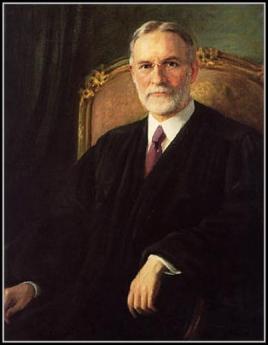
|
| Justice George Sutherland |
There is no need to go further than this, harsher words will only inflame the reaction further than necessary to justify a pull-back. And yet, the Supreme Court would do us mercy if it doused these flames; the Supreme Court needs a legal pretext. May we suggest that Justice George Sutherland, who sat on the court seventy years ago, may have sensed the direction of things, short of using a particular word. Justice Sutherland recognized that although it is impractical to waver from the principle that ignorance of the law is no excuse, it is entirely possible for a person of ordinary understanding to read law in its entirety and still be confused as to its intent. He thus created a legal principle that a law may be void if it is too vague to be understood. In particular, a common criminal may be even less able to make a serious analysis. Therefore, at least in criminal cases, a lawyer may well be void for vagueness. In this case, we are not speaking of criminals as defendants or civil cases of alleged damage of one party by a defendant. Here, it is the law itself which gives offense by its vagueness, and Congress which created the vagueness is the defendant. Since we have just gone to considerable length to describe the manner in which Congress is possibly the main victim, this situation may be one of the few remaining ones where a Court of Equity is needed. That is, an obvious wrong needs to be corrected, but no statute seems to cover the matter. The Supreme Court might give some thought to convening itself as a special Court of Equity, on the special point of whether this legislation is void for vagueness.
We indicated earlier that one word was missing in this bill of particulars. That would be needed, to expand the charge to void for intentional vagueness, an assessment which is unflinchingly direct. It suggests that somewhere in at least this year's contentious processes, either the Executive Branch or the officers of the congressional majority party, or both, intended to achieve the latitude of imprecision, that is, to do as it pleased. Anyone who supposes the general run of congressmen voluntarily surrendered such latitude in the Health and Finance legislation, has not been watching much television. Given the present vast quantity of annually proposed legislation, roughly 25,000 bills each session, the passage of a small amount of vague legislation might only justify voiding individual laws, whereas an undue amount of it might additionally justify a reprimand. However, engineering laws which are deliberately vague might rise to the level of impeachment.
Cost of Medical Care
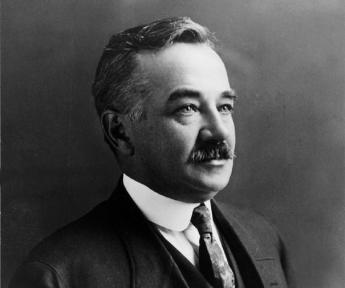
|
| Milton S. Hershey |
On several occasions, Richard A. Kern M.D. (1891-1982) told the story of his part in the founding of the Hershey School of Medicine. Dick Kern was a distinguished professor of Medicine at Temple University, well known for his contributions in the field of asthma and allergy, a past president of the College of Physicians of Philadelphia, and a former Grand Master of Pennsylvania Freemasonry. The Milton S. Hershey School was considering the creation of a medical school and needed advice.
Milton Hershey had been a strict Mennonite, which is closely related to Quakerism, and had accumulated a huge fortune making chocolate candy. He left generous trusts to endow a theater and various other public services in the town of Hershey, but his ownership shares in the chocolate company had been left to the Hershey School for orphans. The value of the shares had far outgrown the ability of the school to employ them usefully, and they were considering a medical school. In 1963, as at present, everybody else was wondering how to get out from under the crushing cost of running a medical school. The sudden inquiry from a donor both willing and able to start a whole new medical school from scratch was an opportunity not likely to appear again soon. Kern carefully considered the options, including the danger of scaring off the naive potential donors with too high a price. Finally, he screwed up his courage and suggested a price to the trustees, of fifty million. The prompt answer was, done, you've got your medical school.
In due course, Kern found himself on the platform at the inaugural ceremonies of the school, sitting next to the guest of honor, that man who had made such an instant decision. Chatting amiably, Kern mentioned that he had always wondered how high the Hershey Foundation would have been willing to go. The answer was just as prompt as the original one. "Hundred-twenty."
A Change of Era
A maxim of the book-editor trade is "Deviate from chronology at your peril." Two events may have little to do with each other, but it always remains possible to show the earlier event had somehow affected the later one. An editor may know little about a topic, but he knows that much.
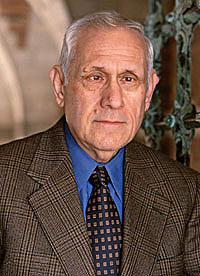
|
| Dean Donald Kagan |
In 2011, I was privileged to be a tuition-paying student at one of Yale's Directed Studies Courses. An invention of former Dean Donald Kagan, the DS courses take an important era in history and apply three conventional faculty disciplines to it at once: Philosophy, History, and Literature. For the undergraduates, courses range in chronology from Ancient Greek to the Enlightenment; so far, the alumni just get the Greeks. Judging only from the course in Ancient Greek, the unspoken thesis soon emerged that a major era experiences permanent changes in history, philosophy, and literature, but the connection between the three is often loose, requiring some pondering to make the connections firm. Aeschylus does have a connection with Plato, and Aristotle with Thucydides but it remains unclear why the connection exists. Furthermore, you can lump these things or split them; Ancient Greece fits naturally with the Roman Empire, but it can also stand alone. Therefore, although the Yale faculty tends to lump the American Revolution with The Enlightenment, a consideration of the life and times of Robert Morris, Jr. fits naturally with both the Enlightenment and the American Era, because the American part of the Enlightenment bifurcates abruptly when Morris stood in debate with William Findlay in the Pennsylvania State House in 1798 -- and lost.
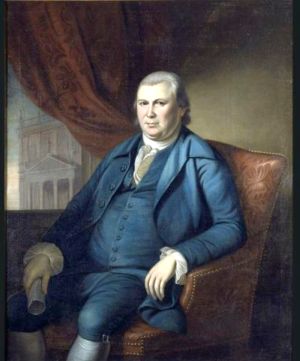
|
| Robert Morris |
Morris was the richest man in America or close to it, the unofficial President of the United States in its darkest hours, the most brilliant non-academic innovator in Western Finance, the leader of American high society, the only man beside Roger Sherman to sign the Declaration of Independence, the Articles of Confederation, and the Constitution. Morris did not realize it but he was within a few months of going to jail for three years, then spending his final five years in secluded disgrace. Robert Morris was not accustomed to closing arguments, but he lost this one, concerning the wisdom of renewing the charter of the Bank of North America, the first real bank of the country. He lost an argument he should have won easily. In retrospect, the new modern American Era was beginning, and he was apparently on the wrong side of it. Politically, that is. Speaking purely of banking and finance, he was a century ahead of his time.

|
| Ancient Greek Gods |
It seemed to me and my alumni classmates that the idea of examining a historical period like the ancient Greek one in the light of three different academic disciplines, gradually assumed considerable merit. The philosophy department examined beliefs which underlay action, and the history department described what those actions turned out to mean inhuman affairs. But the literature department came far closer than either of the other two, to imparting to a reader just what it was like to be an ancient Greek. Professor Kagan seems to have a really good idea here, although it must be resource-expensive to develop, academically. Three departments of Academia have to come to some sort of agreement about the whole synthesis, an agreement which surely must not have been present at the start. It must be a process highly similar to a medical school teaching about a disease, with coordinated input from pathologists, surgeons, and internists. A nice idea, but terribly labor-intensive of labor of the highest quality. Book editors would say it is safer to stick with chronology as an organizing principle if you plan to do a lot of organizing. Nevertheless, I must express my gratitude to Yale for allowing me to be a spectator at an experiment conducted by masters of the thinking trade. Its results must be judged by standards other than the usual ones.
The First and Oldest Hospital in America
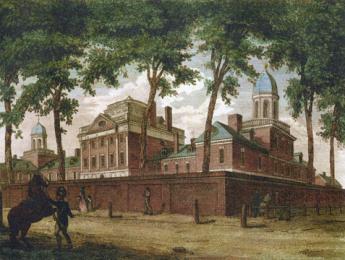
|
| South East Prospect of Pennsylvania Hospital |
There is a painting of the region around 8th and Spruce Streets in the 1750s, depicting a pasture, with cows, and three or four buildings between 8th and 13th Streets. When the Pennsylvania Hospital moved there in 1755 from its temporary location in a house located a block from Independence Hall, there were complaints that it was now located so far out in the woods that it was difficult and dangerous to go there. Still another description of the area is evoked by the provision which the Penn family placed in the deed of gift of the land, strictly forbidding the use of the land as a tannery. Tanneries have always been notorious for giving off noxious odors, so most people wanted them to be somewhere else, anywhere else. In any event, the main activity of Penn's "green country town" at that time was concentrated closer to the Delaware River, and the nation's first hospital was definitely placed in the outskirts. Two blocks further West the almshouse was already in place, but not much else. We are told that Benjamin Franklin had flown his Famous Kite at 9th and Chestnut, using a barn there to store his materials. It might be recalled that the population of Philadelphia, although the second largest English-speaking city in the world, was only about twenty-five thousand inhabitants at the time of the Revolution, and in 1751 was even smaller.
In any event, the first and oldest hospital in America was built on 8th Street between Spruce and Pine, and the Eighteenth Century buildings on Pine Street still present a breathtaking view at any season, but particularly in May when the azaleas are in bloom, and fragrance from the flowering magnolias fills the evening atmosphere for blocks around. Although some people today mistake the Pennsylvania Hospital for a state hospital, it was founded in the reign of George II, decades before there was such a thing as the State of Pennsylvania. The Cornerstone was laid by Benjamin Franklin, with full Masonic rites. Most doctors regard a hospital as a mere workshop, but the affection with which many Pennsylvania physicians regarded their special hospital is indicated by the number who have requested that their ashes be buried in the garden.
For two hundred years, beginning with the first American resident physician Jacob Ehrenzeller, the interns and residents were paid no salary, so they had to live on the grounds. An Internet was just that, interned within the four walls for at least two years. Because the resident physicians had no money, they stayed in the hospital at night and on weekends, playing cards and swapping stories. The hospital was home for them, as it was for the student nurses, likewise unpaid but more strictly confined and supervised. This penury seemed acceptable because the patients were mostly charity ward patients, otherwise unable to pay for their own care. Ehrenzeller finished his medical apprenticeship and went to practice for many decades in the farm country of Chester County, but gradually upper-class Philadelphia moved from 4th Street westward to and beyond the hospital, and two of the richest men in American history, Morris and Biddle, had houses within a block of the hospital, although Morris never lived in his house, having more pressing matters in debtor's prison. Therefore, later resident physicians at the hospital had the potential of setting up a private practice in the area and becoming society doctors as well as academically prominent ones. Being a charity hospital in a rich neighborhood created the potential for volunteer work by the town aristocrats and large bequests for charity. The British housed their wounded in the hospital during the Revolutionary War and shot deserters against the red brick wall of the small cemetery to the north. A century later, there were a couple of dozen rooms for private patients in the hospital for the convenience of the doctors and the neighbors, but everyone else was a charity patient. And a century after that, the hospital still did not have an accounting department to collect bills and tended to regard people who asked for a bill as a nuisance. Benjamin Franklin is regarded as the Founder of the hospital, and his autobiography famously describes how he fast-talked the legislature into matching the donations of the public, not mentioning to them that he had already collected enough promises to see the project through. This seems in character; Franklin's biographer Edmond Morgan summed up that, "Franklin doesn't tell us everything, but what he does tell us, is straight." The idea for the hospital was that of Dr. Thomas Bond, whose house is now a bed and breakfast on Second Street, but it was characteristic of Franklin to be the secretary of the first board of managers of the hospital. In Quaker tradition, the clerk of a meeting is the person who really runs the show. It thus comes about that the minutes of the founding board were recorded in Franklin's own handwriting, among them the purpose of the institution, which is to care for the Sick Poor, and if there is room, for Those Who can pay. This tradition and this method of operation continued until the advent in 1965 of Medicare when charity care was displaced by concepts which the nation had decided were better. The Pennsylvania Hospital was not only the first hospital but for many decades it was the only hospital in America. Its traditions, sometimes quaint and sometimes glorious, cast a long shadow on American medicine.
REFERENCES
| America's First Hospital: The Pennsylvania Hospital 1751-1841 William Henry Williams Ph.D. ISBN-10: 0910702020 | Amazon |
Lindbergh Baby Kidnapping Trial
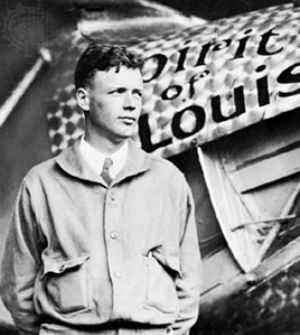 |
| Lindberg |
In 1935, Bruno Hauptmann was executed for kidnapping the baby of America's "Lone Eagle". Swarms of competing police and reporters made chaos of the scene, and Charles Lindbergh made it all worse by dealing directly with the crime underworld. Even today, some question the guilt of Hauptmann, and even whether the baby is really dead.
We are indebted to George Hawke, who went to prep school near the scene of the crime, for becoming an expert, perhaps the preeminent expert, on the Lindbergh Baby Kidnapping Trial. Charles Lindbergh, the son of a midwest pro-German congressman, flew an airplane alone across the Atlantic in 1927. He became instantly famous, wrote a best-seller called Alone, became Colonel Lindbergh, married Anne Morrow the daughter of Senator Morrow of New Jersey. That's how in short order they came to settle in Englewood, New Jersey, and also could afford an elaborate country place in Hopewell, Hunterdon County. That put them physically at the northern edge of the Philadelphia region at least on weekends, although psychologically they remained part of the New York scene, where many people attracted to publicity seem to gravitate. In 1932 they had a 19-month old son, John, who one evening disappeared from Hopewell, apparently kidnapped.
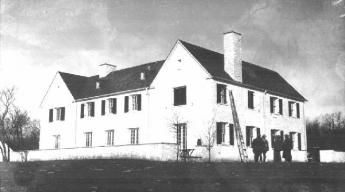 |
| Charles Lindberg Home |
What followed was a Keystone Kops Komedy in the midst of a publicity storm. The local, county, and state police, plus the FBI struggled with each other for the fame of solving the case. Newspaper reporters from all over the country swarmed down the little country road to set up shop. To illustrate the consequences, a home-made ladder was found sixty feet from the house, but no fingerprints were found by the first investigators. By the time the last investigators were done, the ladder had 150 sets of fingerprints on it. Police involvement on all levels can be summarized as a frenzy to be first to solve the case, followed in time by a frenzy to avoid being known for failing to solve it.
Although most of us eagerly following the case were unaware of it, the Colonel decided to take matters into his own hands. As a new celebrity, he was surrounded by many new best friends, and it was suggested to him that he should put out feelers into the Underground, the Mafia Mob. He would pay a ransom, and no questions would be asked. Somehow, a Bronx school principal, Dr. John Condon, was designated to respond to feelers, among them a particularly likely one, from a man who demanded to be met in a cemetery at night. As proof that the baby was still alive, the cemetery lurker sent Dr. Condon the baby's sleeping suit. Ransom was then paid in cash, unmarked, but entirely in gold certificates which had stopped being issued after President Roosevelt took us off the gold standard. The serial numbers carefully recorded. The extortionist then disappeared from sight, and the baby was never heard from again.
As time passed, two things happened. A partially decomposed baby's body was found buried a couple of miles from Hopewell, although it must be admitted it was only a quarter of a mile from an orphanage. The baby's pediatrician could not identify the body, although at the trial others claimed to make such identification. The baby's skull had been fractured, but several detectives had been seen turning it with sticks. The other development was that gold certificates bearing the recorded serial numbers began turning up in the Bronx.
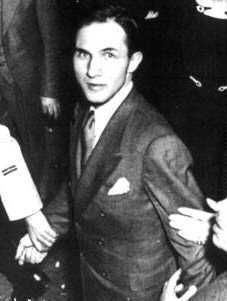 |
| Bruno Richard Hauptmann |
Bruno Richard Hauptmann was apprehended at a filling station after passing a ten dollar bill of the ransom money, and when his house was searched, $14,000 more was found hidden. The police had their man. To say that the house had been searched thoroughly was quite an understatement, but a number of detectives said there was no visible disturbance in the attic. Later on, a rung of the homemade ladder found at Hopewell was found to have exactly the same grain pattern as a piece of attic floorboard, now found to be missing in the Bronx house. Although there was testimony that Hauptmann had been beaten with a hammer, he was deemed a highly suspicious character. He had a criminal record in Germany, and was in this country illegally after jumping ship.
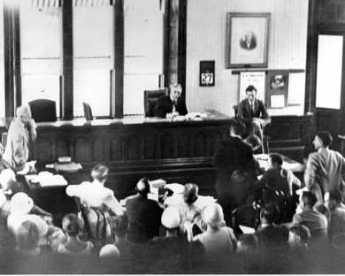 |
| Lindberg Trial |
The Trial of Bruno Hauptmann in the Hunterdon County Courthouse at Flemington was a tumultuous circus. The state of New Jersey spent well over a million dollars on the prosecution, while Hauptmann spent $2900 on his defense, most of it provided by a newspaper, and most of it spent on a defense lawyer who appeared before a jury of farmers dressed in a cutaway, wearing a Carnation and Spats, and who told people in a bar that Hauptmann was anyway guilty. That lawyer seemed visibly inebriated much of the time, and often walked down the main street with a girl on both arms. Miles of new telephone wire were strung into the courthouse area for the reporters, and two switchboards were provided.
There were legal difficulties. At that time in New Jersey, kidnapping was only a misdemeanor, so accidental death in the course of kidnapping was not a capital offense. The Lindbergh Kidnapping Law was hastily enacted to make kidnapping a federal felony, but for the purposes of this trial, it was necessary to prosecute Hauptmann for the crime of Burglary of the sleep suit, with accidental death in the course of that burglary. Hauptmann steadfastly, and to some convincingly, denied everything. He was keeping the gold certificates for a friend.
The jury was understandably confused by all this, but it looked to them as though Hauptmann was surely guilty of something, perhaps extortion, and for all the jury knew Congress would now pass a special law about that, too. The defense did not make enough of the sleep suit, but all the jurors surely knew that such garments could be bought in any department store. There was even some question whether the Lindbergh Baby might not be dead at all, but the fact remained that Hauptmann was definitely guilty of something. He was electrocuted, and the newspapers made a great fuss about that, too.
Philadelphia Mafia: The First Fifty Years
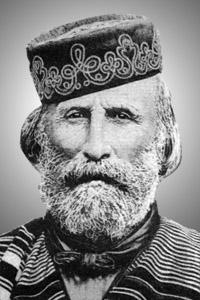 |
| General Giuseppe Garibaldi |
General Giuseppe Garibaldi unified Italy, but a great many Italians either didn't want to be unified, or emigrated to America after 1860 to escape the turmoil. The far western tip of Sicily was the most remote place in Europe, protected by mountains and volcanoes, speaking its own language, and loyal to no government except its own informal one. Over a period of centuries, secret traditions of feudalism and invisible governance had protected Sicily from invaders of various sorts. Although religion was a powerful force, theirs had traces of the Greek Orthodox Church; allegiance to the Vatican faded out as the local priesthood got closer to it. These people mostly wanted to be left alone, and dealt with outside authority in various devious ways, not stopping with murder if necessary. Informal taxes were collected as "paid protection" since a secret army costs money if only to support funerals and soldiers' widows. Rank within the underground army was identified by various degrees of "honor", which could sound vague but were in fact quite unambiguous. Central to the code of the Sicilian underground government, like all guerilla movements was a strict rule of silence, "omerta". As an intern in a hospital accident room, I have seen members of this organization actually go to their deaths, grimly repeating the mantra, "I don't know nuthin."
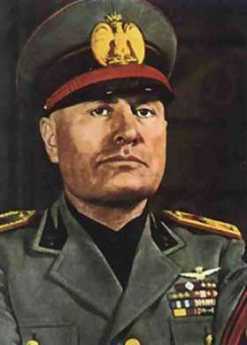 |
| Benito Mussolini |
Italy may have been unified by Garibaldi in the sense of being freed of French, Austrian and Papal domination, but unification was far from peaceful and contented, with losers often choosing emigration. A second wave of emigration was provoked by the harsh rule of the dictator Benito Mussolini, who determined to squelch underground resistance once and for all.
Western Sicilians originally chose New Orleans as their new home, which unfortunately for them already had its own secret society, the Ku Klux Klan. A prompt reaction to the "Italians" with ten or twelve lynchings soon convinced the Sicilians to resettle elsewhere. It seems possible that some of the later techniques of the Mafia were learned from the Klan. In any event, the Sicilians split into two main groups, one going to New York and the other to Philadelphia. Offshoots of the New York group moved to the mining areas of Luzerne County in central Pennsylvania (Hazelton), while another early group migrated to Norristown. There were, of course, links of intermarriage among these groups, but in the early years they drifted apart as separate colonies.
Italian immigrants were no exception to the common tendency of new immigrant groups to gravitate into crime. Records of the Pennsylvania police and jail systems for three centuries show successive waves of inmates with surnames identifying Scottish, then German, then Irish, and eventually Italians. At present, seventy percent of prison inmates are black. Almost without exception, the main victims of immigrant predation have been members of their own immigrant group. Immigrants are easily victimized, somewhat defenseless, and uncertain of the assistance of local law enforcement. Among the most famous of the lawless predator groups among the Italians was the Black Hand, whose specialty was extortion with notes signed with a black hand symbol, enforced by putting bombs under porches. Locals will show you a place on Ninth Street a couple of blocks from the Pennsylvania Hospital where the Black Hand blew things up. The Black Hand, however, was not the Mafia; it exemplified what the Mafia was formed to control.
The Italian community for fifty years was centered on Christian Street, mostly between Eighth and Ninth, gradually migrating westward toward Eleventh Street. Christian Street had been named by the Swedish Philadelphia colony after their monarchs, but the original Swedes tended to remain in Queen (Christina) Village, along Delaware, while the newer migrants drifted to newer areas. During the Civil War, northern railroads heading south ended in Camden. In time, the main Civil War traffic ferried across the Delaware River to wharves at the foot of Washington Avenue. South Street was the honky-tonk area, with a black community growing along with it. After the War, an immigration station was constructed in the Washington Avenue wharf, and the new Italians tended to settle nearby. As the streets were extended westward, the street names were also extended, but the region of Eighth and Christian was largely open fields when the Italians moved into the area, and never had been Swedish. Although there were forty or more murders in the block of Christian from Eighth to Ninth in ten years after the first World War ("Murderers Row"), in modern times the neighboring region is prized by Italian residents as an extremely safe place to live, because the Don likes it nice and quiet.
While it is probably true this safety net quality might not be so evident to blacks and Vietnamese, the safe streets for Italians feature are universally attributed to the Mafia. The Sicilian group quickly reestablished the secret army of "soldiers" and "dons" (usually one don overseeing ten soldiers), started collecting taxes in the form of protection money from the local residents, and putting one "capo" in overall command. You had to be a Sicilian, and a Western Sicilian at that, to be eligible for membership in this secret army. The hierarchy was secret but could be surmised by the elaborate "respect" paid by one to another.
My office partner, Dr. Robert Gill, tells a story illustrating the paying of respect. He was called in consultation to an Italian home by Dr. Baglivo, a highly respected general practitioner in the Italian community. The two of them walked down Eighth Street, and as they passed a barber shop, Dr. Baglivo suggested they both go in for a haircut. Evidently, the patient to be visited was a very important person, and as they went in the shop, Dr. Baglivo introduced Dr. Gill to the group of assembled loiterers as the big doctor from the Pennsylvania Hospital, come to visit you-know-who with the last name ending in a vowel. The group jumped to their feet, in respect, and the barber turned to the lathered-up, half-shaved man in the barber chair. "You!", he cried out, "Get out of that chair! Let the Doctor have a haircut.!" The man dutifully scrambled out of the chair with shaving cream dripping, and humbly sat in a waiting chair, while the big doctor got his haircut. As they left the shop, payment for the haircut was elaborately refused. The point, of course, is not so much one of respect for the medical profession, as respect for someone who had been chosen to attend a capo.
The Mafia was thought to do a fair amount of slashing and breaking of kneecaps, but killing was not permitted except at the order of the boss, or capo. The police could be fairly tolerant of informal methods of law enforcement, but dead bodies brought newspaper attention where even paid-off politicians might not be able to shield the Organization from "heat". For the first forty years, members of the Mafia were sort of volunteer firemen, earning their living as tradesmen and laborers; Mafiosi were paid protection money but were not generally wealthy. The identity of the capo was for forty years a complete mystery to the non-Sicilian community.
But then, along came Prohibition.
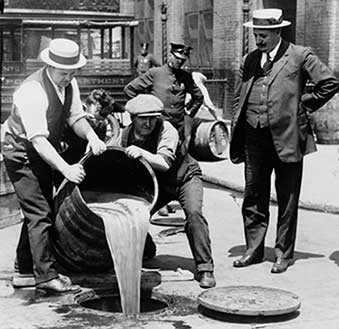 |
| Prohibition |
Prohibition created big money fairly safely, so bootleggers proliferated widely. It was soon no longer possible for one tightly-knit fraternal organization to intimidate a whole host of petty criminals acting alone or in small groups, so the Mafia was forced to control the bootlegging industry through dominating its sources of supply. As a general rule, "rum-running" involved bringing in conventional brand liquor from Canada. That route made Chicago, Boston and New York the major entry and distribution points for "good stuff". From Philadelphia south, most illegal liquor was "moonshine" or other illegally distilled products. Some liquor was distilled in abandoned buildings and garages, but a substantial amount was distilled in the Pine Barrens of nearby New Jersey. The colorful history of the Teamsters Union can be traced in part to the transportation network established for conveying one form of bootleg or another to its retail destinations. Trucks were often hijacked, so paid protection took a new motorized form. The manpower required soon exceeded the number of Sicilian neighbors related by intermarriage. Local groups had to be coordinated with national groups, requiring the establishment of syndicates and governing councils. Even then, one group of recognized Mafia might collide with another; the resulting murders had to be negotiated through a quasi-judicial appellate system.
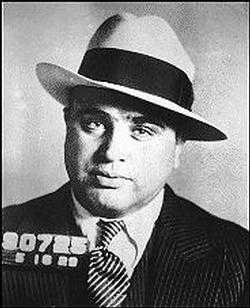 |
| Al Capone |
Philadelphia appears to have had a share of gangland warfare, but mainly that was based in Chicago and New York. In one year, Chicago experienced four hundred gangland murders, Philadelphia only forty. Al Capone came to visit Philadelphia, for reasons unknown, was assured he was most unwelcome and got himself put in jail, for his own protection. Eastern Penitentiary likes to show off his well-decorated cell, to which meals were apparently catered. What was really going on remains a mystery. A group of ten Philadelphia Mafiosi is now known to have gone to New York to participate in the "Castellammerese Wars", where two large New York Mafia groups engaged in a fierce battle for supremacy in what was now a source of vast riches. Occasional lurid episodes like this surfaced in Philadelphia, but the Mob was determined to remain as obscure as possible, and many details are missing or deliberately misrepresented. The essence of it all was that Prohibition had transformed the Mafia from a little vigilante group who imposed law and order on a lawless immigrant community, into a tightly organized army of killers, who mostly devoted their war efforts to exterminating rival tribes, while their daily activities consisted of running marginally tolerable criminal activities like gambling and loan sharking.
sting book by Celeste A. Morello called Before Bruno. In 1927, the Mafia decided they could no longer tolerate the Zanghi gang of four or five or a somewhat larger gang of Lanzetti brothers. On Memorial Day, 1927, several Zanghi members were standing on the corner of Eighth and Christian, when they were approached by several men in black overcoats. Down the street came a car with several others carrying shotguns. After the smoke cleared, three Zanghi (one of them the uncle of Mario Lanza the singer) were lying in a pool of blood, and the car went careening down Christian Street with four Mafiosi, including Salvatore Sabella, crouched on the running boards. "Musky" Zanghi, who was intended as another victim, emerged from the neighboring building and acted like a crazy man. "Sabella," he cried, "Sabella did it!". And he continued to squeal, right into the police station and newspapers. The unthinkable had happened; someone ratted. As it turned out, Sabella was revealed as the Capo himself, and general consternation ensued. Just how this information got circulated is unknown, but a story has it that $50,000 was paid to Musky to shut his mouth, Musky failed to appear in court as a witness, the court system was persuaded to blame the whole thing on an unknown underlying named Quattrana (who went to jail for eight years), everybody else was not guilty, Sabella retired as capo at the remarkably young age of 40 and lived for years in Norristown. In fact, because of the 1929 crash, Sabella the capo had to work as a butcher in Norristown, receiving small gifts as a pension. And, as these undocumented stories would have it, it took fifteen years but eventually someone, surely a friend of Sabella, "got" Musky Zanghi, who was hiding out in New York.And the Lanzetti brothers? Well, they got eliminated, reputedly by Sabella's successors in the organization, but the violence triggered extensive Grand Jury investigations led by Judge Edwin O. Lewis, later the father of Independence Mall. Thereafter, mob rubouts became considerably less frequent. Although newspaper and FBI activity had been extensive, and apparently effective, a more detached view makes it more likely that repeal of the Volstead Act was the major factor causing mob activity to subside.
REFERENCES
| Blood and Honor: Inside the Scarfo Mob, the Mafia's Most Violent Family George Anastasia ISBN-13: 978-0940159860 | Amazon |
| Before Bruno: The History of the Philadelphia Mafia Book 2 C. A. Morello ISBN: 978-0967733425 | Amazon |
| The Last Gangster George Anastasia ISBN-13: 978-0060544232 | Amazon |
| The Last Mouthpiece: The Man Who Dared to Defend the MobRobert F. Simone ISBN-13: 978-09401596932 | Amazon |
REFERENCES
| The Pine Barrens: John McPhee: ISBN-13: 978-0374514426 | Amazon |
Google Earth Tour of Franklin Locations
On the front page of Philadelphia Reflections is found a button which will download Google Earth, and if you follow instructions on the left column, will give you a satellite tour of every blog let on the site. At least, it will when we get it finished; it's only about half complete at present. If you are unfamiliar with this approach, we suggest you download the Earth program from the Google site and get acquainted by locating your own house, or Independence Hall, or the Vatican.
In addition, every Topic (listed in the left-hand column of the front page of Philadelphia Reflections) will contain a button which generates a tour of the geoTags of that particular Topic, providing there are three or more such tags. You will generally get the best results from tours developed by unknown authors if you turn off ALL of the layers provided in the lower section of the left-hand panel of Google Earth, although you might turn them on, one at a time if you want to enhance the effects. Generally speaking, the route of Interstate 95 seems a little out of place among the local wanderings of Ben Franklin.

|
|
Take a satellite tour of nearly every place Ben Franklin ever visited. |
You should also become familiar with KMZ files and KML files. Keyhole markup language gives instructions to Google Earth, allowing authors like Bob Florig to organize tours of a particular subject. KML files are quite large, so they get compressed to make them easier to send over the Internet. Compressed files of KML are designated KMZ, referring to Winzip the decompressor. Other decompressors will often work, too, especially Stuffit for Apple users. The extra step of decompression is a nuisance, and it is possible to have the file do things itself, to become known as a self-extracting file. Self-extracting files are often, but not always, designated as EXE files.
You are here invited to take a tour of every site Benjamin Franklin is known to have visited as if you were an interplanetary alien riding a flying saucer. Double-click the blue link to download a copy of Google Earth if you don't already have one, followed by a self-extracting KMZ file constructed by Bob Florig and used with his kind permission.
There's one other feature you should know about, called overlays. Bob took an 18th Century map of Philadelphia and substituted it for the satellite map of contemporary central Philadelphia. That lets you see Philadelphia as Franklin saw it, and by changing overlays, also allows you to see the little red-brick buildings which remain standing among the skyscrapers. Both he and I are uncertain about the copyright status of the old maps and may have to remove them if the author identifies himself and protests.
Ageing Owners, Ageing Property
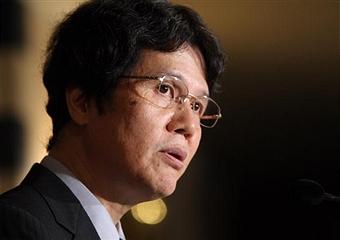
|
| Kiyohiko Nishimura |
Kiyohiko Nishimura is currently the Deputy Governor of the Bank of Japan (BOJ), and as such is expected to have wise things to say about finances, as indeed he does. Japan has a far older culture than the United States, and a botanical uniqueness growing out of the glaciers avoiding it, many thousands of years ago. But its latitude is approximately the same as ours, and its modern culture is affected by the deliberate effort of the Emperor to westernize the nation, following its "opening up" by our own Commodore Matthew Perry in 1852. Perhaps a more important relationship between the two cultures for present purposes is that Japan has been suffering from the current deep recession for fourteen years longer than we have. We don't want to repeat that performance, but we can certainly learn from it.
Mr. Nishimura lays great stress on the aging of the Japanese population because, in all nations, houses are mainly purchased by young newly-weds, and sold by that same generation years later as they prepare to retire. If a nation has an elderly population, it can expect a general lowering of house prices someday, reflecting too many sellers leaving the market at the same time. The buyers of those houses are competing with other young people, so the simultaneous bulges and dips of the population at later stages combine to have major effects on housing prices. At the moment, younger couples are having fewer children as a result of women postponing the first one. Nishimura goes on to reflect that something like the same is true of stocks and bonds, although at age levels five or ten years later. One implication is that retirement of our own World War II baby boom is about to depress American home prices, which will likely stay lower for 10-20 more years. Furthermore, our stock market will have a similar effect, stretching the depression out by as much as 5-15 years. The Japanese stock market has been a gloomy place to be during the past fifteen years, and by these lights might continue in the doldrums for another five or so. Meanwhile, our own situation predicts an additional generation of struggle while Japan is recovering. It's best not to apply these ideas too closely, of course, but surely somebody in our government ought to dig around in the data, at least telling us why we ain't goin' to repeat this pattern. Please.
Perhaps because they eat so much rice and fish, the Japanese already have a longer life expectancy than Americans do, but in terms of outliving your assets, that's not wholly advantageous, the way a love of golf might be. The best our nation might be able to do is to examine some of our premises about housing construction. In Kyoto, most houses were built with paper walls, for example.
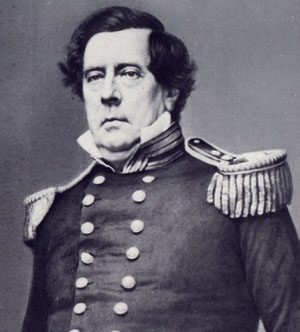
|
| Commodore Matthew Perry and Japan |
The house walls of the town of Kyoto were in fact made of waxed paper, which seems to work remarkably well. While no one now advocates going quite that far, we might think a second time about building the big hulking masonry houses so favored in our affluent suburbs. Such cumbersome building materials almost dictate custom building and strongly discourage mass production. How likely are such fortresses to survive in the real estate markets of fifty years from now? Judging from my home town, not too well. Haddonfield boasts it has been around since 1701, and there are at most three or four of its houses which have survived that long. We favor great hulking Victorian frame houses, with a good many bedrooms unoccupied, and high drafty ceilings, very large window openings and little original insulation. The heating arrangements have gone from fireplaces to coal furnaces, to oil, and lately to natural gas. The meter reader who checks my consumption every month tells me that almost all the houses now have gas heat, so almost all the houses are using their second or third heating plant, along with their eighth or tenth roof, and thirty coats of paint. This kind of maintenance is not prohibitively expensive, but just wait until the plumbing starts to go, and leak, and freeze, with attendant plastering, carpentry, and painting. Our schools and transportation are excellent, so we have location, location, location. But when the plumbing, heating, and roofing start to require financial infusions all at once, you get tear-downs. A tear-down is a new house in which a specialist builder buys the old house, tears it down, and looks for a buyer to commission the new house on an old plot of land. Right now, there appear to be six or eight such Haddonfield houses, torn down and looking for a buyer to commission a new house on that location, location. If we repeat the Japanese experience, there will be some unhappy people, somewhere. And that will include the neighbors like me, who generally do not relish languishing vacant lots next door, but fear what the new one will be like.
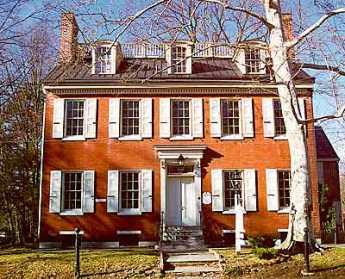
|
| Greenfield Hall |
The thought has to occur to somebody that building the whole town of less substantial materials in the first place would be worth investigation, replacing the houses every forty years when the major stuff wears out. At the present, when a town of several thousand houses has five or six tear-downs, the neighbors would not tolerate replacing tear-downs with insubstantial cardboard boxes. Seeing what has happened to inner-city school systems, the neighbors would be uneasy about "affordable housing" built in place of stately old Homes of Pride. In time, that might lead to a deterioration of one of the two pillars of location, location -- the schools -- and hence to a massive loss of asset value. And yet when those houses empty out the school children, leaving only retirees in place, the schools will not be worth much to the owners or in time to anybody else. There's an unfortunate tendency for local political control to migrate into the hands of local real estate brokers, so you had better be sure any bright new proposal is tightly buttressed with facts.
The only real hope for evolution in this obsolete system may lie in the schools of architecture, strengthened perhaps by some research grants. Countless World Fairs have displayed the proud products of their imaginative thinking, but mostly to no avail. Perhaps the ideas are not yet ripe, but since it would take more than a generation to create a useful demonstration project of whatever does become ripe for decision, let's start thinking about some innovative suburban designs, right now.
Anatomy of an Urban Political Machine

|
| One Big Family |
The Franklin Inn Club meets every Monday morning to discuss the news, and recently it discussed the upcoming local political campaign. The discussion went on for fifteen minutes before a newcomer asked if we were talking about the primary or the general election. The question was met with broad smiles all around because of course, we were talking about the primary. Voter registration is 6:1 in favor of the Democrats in Philadelphia, so the general election is just a required formality. The election, that is, consists only of the Democrat primary; election of the Democrat nominee in the general election is a foregone conclusion. Someone idly remarked on the number of politicians who are blood relatives of other politicians, someone else said that was true of union officers, too. So, skipping from the inside baseball of the election, we took a little time to discuss the anatomy of an urban political machine.
The first step in consolidating control of a city by a political machine is to eliminate the issue of the general election by making the other party's chances seem hopeless. That converts an election which typically turns out 40% of the voters into an exclusively primary election, turning out 20% of the voters, or even less in an off-year. In some "safe" districts a winner needs far less than 10% of the eligible voters to win.
The second step is to run as a prominent member of a local ethnic or religious group, preferably the largest of such groups within the district. If possible, an election is almost assured by being the sole candidate associated with the largest ethnic group. Here's where family connections work for you. If your father held the same seat, or some other family member had been prominent in the district, it helps assure everybody that you are really an ethnic member and not just someone whose name sounds as though it would be. Your relative will know who is important in locally local politics, the members of large families or people are known to be the "go-to guy".
Assembling all that, the final step is to get everyone else who is a member of the ethnic group to drop out of the primary, and to encourage other ethnic groups to field as many candidates as possible, splitting up their vote. Getting other members of your religious group to drop out, consists of having your relative approach them and tell them to wait their turn. The implicit promise underneath that advice is probably next to worthless, unless it is specific and witnessed, and the other fellow's ability to deliver it is credible. If all else fails, the resistant opponent is muscled in some way, verbally at first, and then increasingly threatening. The consequence of this ethnic/religious influence is more involvement in government by clergy than is healthy for either one of them. Now, that's about all there is to achieving permanent incumbency, but the minority party should be mentioned, as well as the flow of money.
It quite often happens that the minority party in the big city, hopeless in its own election chances, finds itself with a Governor and/or Legislature of their party. The patronage of state jobs becomes available to the foot soldiers who have no chance of local election. Much of the wrangling within state legislatures revolves around whether appointive patronage jobs should be lodged in state agencies, or local ones; at the moment, the Parking Authority and the Port Authorities figure prominently as jobs for which a local Republican could aspire. The coin of this trade is maintaining influence in the state nominating process and paying off with increased voter turn-out in elections which have no local effect but may be important at the state or national level. Since party dominance at state and national levels changes frequently, the local machine finds it useful to continue this system. Where they have nothing to lose in local elections, they may even encourage it.
Money is the mother's milk of politics. Except for safe districts no one can get elected without it. And various degrees of corruption provide money to be "spread around" the clubhouse, sometimes to induce people to drop out of primary races, sometimes to console "sacrifice" candidates who run hopeless campaigns just to make the party look good, and sometimes just to enrich the undeserving. The politically connected parts of the legal profession participate a good deal in the flow of funds, sometimes in order to get government legal work, sometimes to obtain judgeships, sometimes to launder the money for clients. One particularly lurid story circulates that professional sports teams are expected to make seven-figure contributions in return for lavish new stadium construction, from which they, in turn, are able to generate various sorts of compensating revenue.
But, as the old story goes, if you eat lunch with a tiger, the tiger eats last.
A Gleam in Washington's Eye
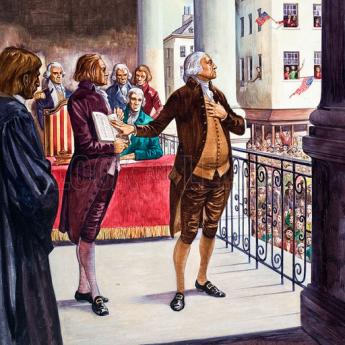
|
| George Washington Taking Oath |
On the eve of the Constitutional Convention, the nation was unhappy, confused, and dissatisfied; this wasn't what a victory was supposed to feel like. George Washington wanted a country to be proud of, big enough to discourage enemies, otherwise free of policing, regulation, or monarchy. Eight years of war had taught him it wasn't easy to have both liberty and discipline at the same time. Perhaps America was more unusually blessed, however, defended from invasion by oceans and wilderness, and from greed by a continent of natural resources. If order and justice could be organized, perhaps this by itself would enlist the loyalty of that mixture of classes and nationalities then flocking to our shores. Several important writers were having a strong influence on the era we now call the Enlightenment; David Hume and Adam Smith in Scotland, Edward Gibbon in England, Voltaire and Diderot in France, even Catherine the Great of Russia, with a thousand others including Benjamin Franklin and Robert Morris. Although Washington probably hadn't read them, Adam Smith's The Wealth of Nations showed unvarnished new ways of looking at commerce and politics, while Gibbon's The Decline and Fall of the Roman Empire showed what could happen if idealism gets neglected. Both books were published in the portentous year of 1776, describing many difficulties, but always suggesting problems could somehow be solved. There were plenty of ideas in circulation, but there was no plan.
It must have become obvious to Washington well before the Battle of Yorktown, that the Revolutionary War would not leave us with our problems solved. There was one brief moment as the British Army was withdrawing from Philadelphia in 1778 which seemingly justified boasts our troops had licked 'em. Just after the surrender of a whole British Army at the Battle of Saratoga, the British were also retreating from Philadelphia, and the Lord North offered generous peace terms through the Earl of Carlisle. No doubt the British public was restless after the Burgoyne defeat and the French alliance with America. Because the Carlisle episode is much more familiar in England than in America, perhaps it was a feint or a maneuver to embarrass the Earl of Carlisle or possibly just an exploration of the true state of affairs which were rumored about across a wide ocean. At any event, Gouverneur Morris was the visible American actor in this puzzling episode, but he must have been acting in concert with others. Lord North offered to give us our own elected parliament within a commonwealth; taxation with representation, no less. Morris seems to have dismissed this offer with contempt. But six more years of devastation ensued, surely convincing Washington that bitter defeat was still possible. That reality was concealed behind the graciousness of the French in allowing us to claim American troops had defeated the British at Yorktown. In fact, the preponderance of troop casualties, naval vessels and strategy had been French. The money had been mostly French as well. If that debt nearly bankrupted France, what might it have done to America?
Washington had been an outstanding athlete, soldier, and farmer, but his many travels about the colonies convinced him something more than leadership was needed. You just can't defeat a powerful enemy with short enlistments which give soldiers a legal right to go home on the eve of battle, and no way for the central command to extend the enlistments. To this, Robert Morris added that you can't buy gunpowder without the central power to levy taxes to pay for them. Morris warned him more was needed than a confederation so big others would leave it alone. Even temporary power wasn't enough. National disorganization had been just as bad after the Revolution as before. By 1787, Washington concluded the states just would not surrender power to a central national government unless the people forced them to give it up, and after a brief patriotic fervor, the people mostly wanted to go home for spring plowing. Peacetime also demonstrated another discouraging truth: meaningful improvement of the existing order meant the whole previous leadership class might leave public service to less qualified leaders, watching peace attract mediocrity to political office. Prominent men in the community gathered in a Constitutional Convention recognized the advantages of Union and devising peaceful ways to maintain it. After that transient moment when the memory of the war was fresh, politics could return to the mediocrities of a political class. That's not exactly what is now meant by "We, the People", but it might have to serve. In Washington's view, the voice of the people usually echoed along the lines of Tell us what good it would do to upset the Articles of Confederation, otherwise leave them alone. If you propose the general shape of a new central government, first tell us what it can do better than the states. And then show us how to make dubious state politicians agree to it. The accents of hesitation and defeat echo powerfully.
The hideous French Revolution was soon to demonstrate how unwise it was to look for short-cuts; we need a republic, not a stampeded democracy. George Washington was unsure just what was needed, but he knew a few basic things with certainty. America needed a bargain which everyone was expected to keep. A stronger central government should be provided for, and make it difficult to dissolve.
Limits of Leverage
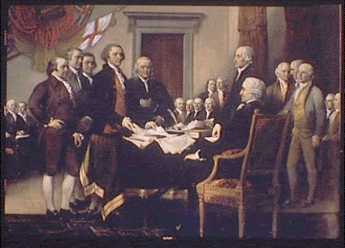
|
| Continental Congress |
PHILADELPHIA was the seat of the Continental Congress, hence the nation's capital, from 1774 to 1790, with two periods of abandonment. After the ratification of the Articles of Confederation in 1781, it became the Confederation Congress. When the British had occupied the city in 1777-78, "the Congress" fled to Baltimore, then to York, Pennsylvania, but returned as soon as the British left. The second period of the flight was occasioned by the near-mutiny of the Pennsylvania Line for lack of pay in 1783, when Congress fled, in succession, to Annapolis, Trenton, Princeton, and New York, leaving General Washington's loyalties torn between sympathy for his starving troops, and firm loyalty to law and order. The chaotic situation suited the British, who dragged out peace negotiations after the Battle of Yorktown and came close to winning by stalling what they had been unable to achieve by arms. The finances of the French government were already stretched beyond what was prudent in view of their intention to invade the British Isles. The much more solvent British began to see India as a more attractive colony than America, particularly if the lucrative trade with Jamaica and other Caribbean islands could be maintained without the expenses of the rebellion. Eight years is a long time for any nation to continue a war without generating significant unrest at home.
 The Constitution did not change taxation much; it changed the people who control our borrowing. 
|
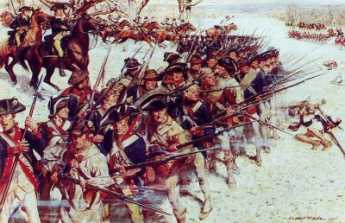
|
| Revolutionary War |
So, although the Revolutionary War was primarily started by British bungling which incited intemperate colonial hotheads into rash behavior, it was going to require a new Constitution and a realistic agreement about everybody's future, to achieve a workable peace. At the beginning of hostilities, only Robert Morris and John Dickinson talked as though they had done some clear long-term thinking, and they both opposed declaring Independence. They were shouted down and forced to go along or be banished. After eight years of fighting, however, a great many people could see that Dickinson may have been right to question the dubious unity of thirteen colonies, while a smaller group could even see that Morris might have been right to focus on Constitutional Liberty rather than regime change. Washington, although he was afraid of little else was fearful about his lack of education beyond grammar school; but at least he knew a country which would not feed its soldiers must be doomed to be no country at all. James Madison was scholarly and knew about Constitutions back to Aristotle, although events proved he had offered himself as a constitutional technician without clear personal goals for the product. Alexander Hamilton and Gouverneur Morris were adventurers, quite willing to shrug off the slogans of war and establish a king, that one form of government they were sure was workable. Only Benjamin Franklin among the colonists had stood before five kings, and of course before Vergennes and Wedderburn, where he could observe that all forms of government were in the hands of agents and intermediaries. But Robert Morris was a businessman who probably wanted little more than a workable set of rules, a level playing field, where he had every confidence that he would win, regardless of other rules for the game. Those rules at a minimum must include an equitable means for the government to pay its debts. As the richest delegate, in his own city, he was encouraged to act as a host for the convention. As host, he felt constrained to speak only about finance, his main concern anyway. Once this point was established fairly early at the Constitutional Convention, Morris had little else to say, even though he personally had many irons in the fire. Everything else, as politicians say, was for sale. Besides which he was accompanied by his personal lawyer but no relation, Gouverneur Morris, who was by far the most elegant speaker and persuasive advocate in the group.
Or perhaps the true flavor of his approach was, One Thing at a Time. Robert Morris was elected U.S. Senator from Pennsylvania in the first Congress under the new Constitution. He was in the center of almost every major debate, member of more than forty committees, often described as running on and off the floor, marshaling votes. The assumption of state Revolutionary War debts was perhaps part of his central drive to establish the full faith and credit of the United States. But the location of the new capital was quite a separate issue. Morris had bought huge acreage across Delaware from Trenton, in the area now known as Morrisville, and he lobbied hard and long to have the Capital located in Trenton, just as Senator Maclay lobbied to have it settle on his own land near Harrisburg. The New York congressional delegation, led by Alexander Hamilton, fought for a New York location, although Gouverneur Morris attempted to favor his own estate, Morrisania, in the Bronx. And of course, it was the Virginia delegation which finally won the prize, on the Potomac opposite George Washington's estate at Mt. Vernon. The location of the capital was important to Robert Morris, but as a realist, he then bought up large tracts of land in the District of Columbia. Owning two sites for a national capital at the same time was a major overextension of Morris' debts which helped lead to his final bankruptcy, although he was involved in so many affairs it is hard to say which was most significant. And indeed, his lobbying from debtors prison was the main source of a new bankruptcy law, which released him from prison. When Morris was seated in the Constitutional Convention, a large number of ideas must have been running through his head. But as far as we can tell, he largely held his peace, apparently content with the significant achievement of establishing federal taxation. Robert Morris had more ideas than anybody, and more energy than was good for him.
Over the centuries, the Constitution has been seen as a marvel of concise prose. Events have reversed the position of the political parties many times, but the Constitution does not change, so much as its meaning evolves. In the case of the federal ability to tax, however, almost nothing matches its malleability. The Revolutionary War was begun in large part because of a two-cent tax on tea, which was in fact a lowering of the tax rate. By the time of the Presidency of James Monroe, the federal debt had been extinguished by national prosperity. By the time of the Presidency of Barack Obama, the economy of the whole world, not just this one nation, is threatened by excessive indebtedness. The brilliant insights of Morris and Alexander Hamilton thus leveraged the industrial world into a situation which was unimaginable in the Eighteenth century. We are today nearly forced into economic recession, in order to pay down the national debt which computers concealed from us. If our creditors lose the faith we can reduce the debt, they will raise interest rates beyond the point where even the present debt can be sustained. The Constitution did not change taxation much; it changed the people who control our borrowing. The borrower is on a long leash, but creditors hold the other end of it.
 Tax References in the 1787 Constitution: Article 1, Section 2: Representatives and direct Taxes shall be apportioned among the several States which may be included within this Union, according to their respective Numbers, which shall be determined by adding to the whole Number of free Persons, including those bound to Service for a Term of Years, and excluding Indians not taxed, three fifths of all other Persons. Section. 7. All Bills for raising Revenue shall originate in the House of Representatives, but the Senate may propose or concur with Amendments as on other Bills. Section. 8. The Congress shall have Power To lay and collect Taxes, Duties, Imposts, and Excises, to pay the Debts and provide for the common Defence and general Welfare of the United States; but all Duties, Imposts, and Excises shall be uniform throughout the United States; To borrow Money on the credit of the United States; To regulate Commerce with foreign Nations, and among the several States, and with the Indian Tribes; To establish a uniform Rule of Naturalization, and uniform Laws on the subject of Bankruptcies throughout the United States; To coin Money, regulate the Value thereof, and of foreign Coin, and fix the Standard of Weights and Measures; To provide for the Punishment of counterfeiting the Securities and current Coin of the United States; To make all Laws which shall be necessary and proper for carrying into Execution the foregoing Powers, and all other Powers vested by this Constitution in the Government of the United States, or in any Department or Officer thereof. Section. 9. The Migration or Importation of such Persons as any of the States now existing shall think proper to admit, shall not be prohibited by the Congress prior to the Year one thousand eight hundred and eight, but a Tax or duty may be imposed on such Importation, not exceeding ten dollars for each Person. The Privilege of the Writ of Habeas Corpus shall not be suspended, unless when in Cases of Rebellion or Invasion the public Safety may require it. No Bill of Attainder or ex post facto Law shall be passed. No Capitation or other direct, Tax shall be laid, unless in Proportion to the Census or enumeration herein before directed to be taken. No Tax or Duty shall be laid on Articles exported from any State. No Preference shall be given by any Regulation of Commerce or Revenue to the Ports of one State over those of another; nor shall Vessels bound to, or from, one State, be obliged to enter, clear, or pay Duties in another. No Money shall be drawn from the Treasury, but in Consequence of Appropriations made by Law; and a regular Statement and Account of the Receipts and Expenditures of all public Money shall be published from time to time. Section. 10. No State shall enter into any Treaty, Alliance, or Confederation; grant Letters of Marque and Reprisal; coin Money; emit Bills of Credit; make any Thing but gold and silver Coin a Tender in Payment of Debts; pass any Bill of Attainder, ex post facto Law, or Law impairing the Obligation of Contracts, or grant any Title of Nobility. No State shall, without the Consent of the Congress, lay any Imposts or Duties on Imports or Exports, except what may be absolutely necessary for executing it's inspection Laws: and the net Produce of all Duties and Imposts, laid by any State on Imports or Exports, shall be for the Use of the Treasury of the United States; and all such Laws shall be subject to the Revision and Control of the Congress. 
|
The Girl in the Red Velvet Swing
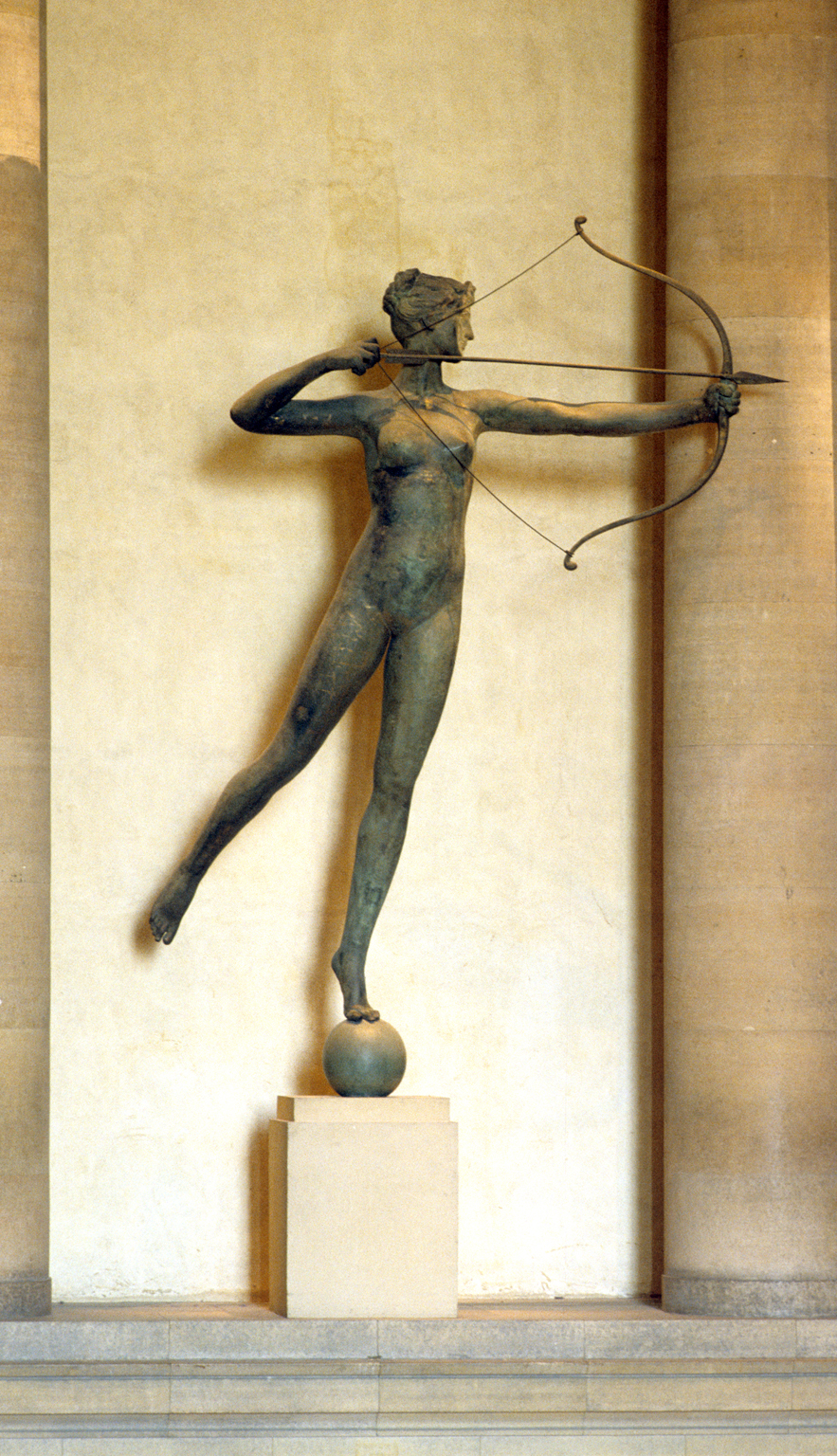
|
| Statue of Diana |
The brownstone house at 1710 Spruce Street is seemingly not remarkable, it's just an Edwardian house now converted to lawyers' offices on the first floor. But it's nevertheless a landmark, curiously linked to that 13-foot statue of Diana which dominates the top of the main interior staircase of the Philadelphia Museum of Art. Many Philadelphia gossips believe the model for the statue was Evelyn Nesbit, who lived in the brownstone on Spruce Street. But she was born in 1884, whereas Augustus Saint-Gaudens created the statue for the 1892 Columbian Exhibition. Since Evelyn was only eight years old at that time, however, it must have been some other woman who took off her clothes to pose for the sculpture; for us, it doesn't matter who she was. The statue was moved to the top of Madison Square Garden when that structure was really still located on New York's Madison Square, but when the Garden was demolished in 1925 the Diana statue came to Philadelphia. Madison Square Garden itself has moved twice in the meantime and is mostly associated in the public mind with prize fights and political conventions. However, when the first Garden was built, it had theaters and roof-top restaurants, and its spectacular nature instantly made the architect, Stanford White, the most famous architect in New York, eventually maybe the most famous one in the world at the time.
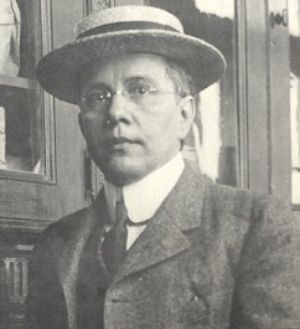
|
| Thaw |
Meanwhile, two residents of Pittsburgh independently came to New York where the action is, the iron and coal millionaire Harry K. Thaw, and an impoverished teenager named Evelyn Nesbit. Evelyn was accompanied by her mother who, recognizing the girl's extraordinary beauty, set about to steer her to fame and fortune. At the age of thirteen she was posing for artists, and in time became the favorite model for Charles Dana Gibson. Gibson created the "Gibson Girl", an idealized role model for millions of women who dressed the way she did, wore their hair the way she did, and behaved in the proper Edwardian style they imagined she did, too. It was in Gibson's studio that she encountered Stanford White. Evelyn had another life, however, as a "Florodora Girl", and one of her many stage-door Johnnies was Harry K. Thaw, the millionaire. That was no saint, having a reputation for using a dog whip on his numerous lady friends, but it is uncertain whether he was completely aware that
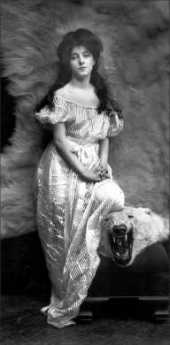
|
| Evelyn Nesbit |
Evelyn was one of the principle entertainers in half a dozen hide-aways that Stanford White is said to have established for naughty parties to amuse New York's fast set. That was certainly aware that Stanford White had been Evelyn's boyfriend before Thaw married her, and the two men cordially hated each other. One evening, some provocation made Thaw walk over to White's table in the rooftop restaurant of Madison Square Garden, and shoot him dead -- in front of hundreds of people. It's a curious sidelight that Stanford White was carrying a train reservation to Philadelphia, to discuss plans for the domed structure of the Girard Bank building. The notoriety of the murder trial was the sensation of the decade, with the prosecutor remarking that White deserved what he got, and Thaw's mother offering Evelyn a million dollars if she would give testimony supporting a plea of insanity. Everyone seems agreed that the money was never paid, although the jury was sure as impressed as the newspaper reporters with Evelyn's refusal on the witness stand to testify against her husband, quite evidently a sign of loyalty. Anyway, the jury let him off, and a famous cartoon depicted Stanford White in the pose of the statue of Diana.

|
| Joan Collins as Evelyn Nesbit "The Girl in the Red Velvet Swing" |
Evelyn sort of dropped out of sight after the trial and the subsequent divorce, until TV interviews were conducted for the movie about the episode, \"The Girl in the Red Velvet Swing". By 1957, Evelyn was decidedly less of a beauty. Meanwhile, Harry K. Thaw had continued to live in the brownstone house in Philadelphia, where once he got sick and called a friend of mine to be his doctor, and eventually another famous professor to be a consultant. When the butler answered the door, the consultant told the butler to tell his employer that he must insist on cash in advance, an action that thoroughly embarrassed my friend in view of the famous wealth of the client. But the consultant had rightly assessed the situation since later Thaw's lawyer called up and told the family doctor he was sorry but his client was not going to pay his bill since the medicine was started by some botanical book to be a poison in excess quantity. In consternation, my friend called up the professor and asked what to do. "Chalk it up to experience," was the answer. "But what have I learned?" The consultant paused, and said, "Maybe you have learned to extend credit only to decent people."
Itch

|
| Dog Itches |
If the reader has had itchy, dry skin, or a diagnosis of eczema before the age of say 65, stop reading right now and go see a dermatologist. Most elderly people have skin problems, but here we talk about elderly people who have developed skin problems for the first time. We particularly talk about brisk busy people who proudly boast they never had skin problems, but boy they sure have them now. Such people have never been to a dermatologist, wouldn't know where to find one, and therefore don't even know the basics of the subject. Furthermore, what they likely have right now is related to old age, because you mostly can't have diseases of old age until you achieve the status of the elderly. So, if you had something like this before, it becomes complicated to distinguish it from the disorders of old age and you better go see a dermatologist.
If that sounds too simple to accept, just think about the following. Dermatitis means skin disease, and eczema is synonymous with dermatitis with the proviso that it oozes, and unfortunately most dermatitis oozes at least to some degree. Take a quick look at eczema in a computer search engine; the first thing it will tell you is the cause is not understood. The second thing it will say is that eczema is mostly found in children. Perhaps now you get the idea; if you have had this in the past, go away and see a skin doctor.
On the other hand, any group of old folks sitting around the table in a retirement home will immediately brighten up at the mention of skin problems, since most old folks have skin problems. These people itch and itch badly. Everyone at any age has been bitten by mosquitoes and had an occasional run-in with poison ivy, but these produce bearable itches; the itch of senile eczema is unbearable, gets your full attention. It keeps you awake at night, and thus makes you drop off asleep during the day. The things everybody learns will give heavenly quick relief are generally agreed to make you worse, don't do them. Scratching makes things worse, leading to a mysterious thickening of the skin known as lichenification (that's thickening of the skin, in Latin) which is sort of a scarlet letter among dermatologists, you bad person. And the second thing is a habit of deep scratching so bad you cover your shoulders and back with little red ulcers without fully realizing you are doing this yourself, excoriating your skin with your fingernails. Since people do this without realizing it, of course, they deny it, and doctors for a long time regarded them as nut cases. However, the current more balanced view is that somehow this kind of excoriation suppresses, depresses or otherwise mysteriously inhibits the unbearable itch. So all of this adds up to saying that elderly eczema drives an old codger to the point of dominating his whole thought process; good manners are damned, he wants to talk about it. Better still, do something about it, right now.

|
| Nummular Eczema |
That being the case, helpful friends of a certain age know what to advise: hydrocortisone ointment, or the even more potent fluorinated steroid ointments. This stuff really works, particularly if there is some sort of visible skin eruption to direct your effort, but it's dangerous to use too much. It makes the skin lesion and the itch vanish in a couple of days, although of course, it is likely to return in a week; keep that up and you will get skin atrophy, and in large quantities will suppress the activity of your adrenal glands. So, if the area of the itch is so small there is no danger from the ointment you probably can get along without it, whereas if the affected area is large, you are unwise to paint yourself with a lot of this poison. You could take the same stuff in pills, but that gets you to a dermatologist, so you are already in the pay grade above where you should self-medicate.
The other home remedy which offers instant relief is hot water. Usually administered as a hot shower lasting a good long time, or luxuriating in a warm tub, or best of all a hot whirlpool bath. Unfortunately, this is really bad news for eczema, almost surely making it much worse. Swimming pools and whirlpool baths are used communally, so they are chlorinated; don't do this to yourself. Instead, do the opposite; go for a week or ten days without a bath. You heard me right, go right ahead and stink. You'll find that deodorants take care of the armpits, so a limited amount of perfume-free soap to the groin and perianal area is the limit. For the rest of your carcass, go back to Biblical times and apply oil, preferably one of the many skin-healing cosmetic lotions that are somewhat overpriced but generally quite soothing. So that's it; no bath for a couple of weeks, use oils for reasonable cleanliness. There's a long-handled lotion dispenser available for a few dollars, that applies the lotion through plastic balls that act like ball bearings. Since being greasy soon becomes part of the problem, this dispenser cleans and soothes with a minimum of oil.
If this suggestion fails to work, you are getting closer to the dermatologist's office every minute, because you have not only stopped scalding your skin in the shower, you have eliminated the perfumes and antiseptics in soaps and detergents. By the way, while going without a bath, go without shampoo as well; most shampoos are detergents. Drying of the skin by excessive bathing, allergy to soaps and detergents, are the main causes of this condition, so if going without a bath doesn't work, you may well not have the common form of the condition. There are a couple more things to try, however. You can moisturize your skin with alpha Keri, take Benadryl to help you sleep, aspirin to relieve the itch. You can consider laundering your sheets with soap, or plain water, or just about anything except sodium laurate, the main detergent which has more familiar trade names. If the itch is localized to identifiable areas, the underwear covering that area should be laundered in plain water, or the mildest form of unperfumed soap. Recently, a fairly new idea has surfaced in the form of little bottles of hand lotion, touted to prevent the transmission of the common cold. Whatever its value or lack of it in the cold transmission arena, this stuff seems to kill surface germs for quite a number of hours; applying it to an itchy area is worth a try, because many itches are really allergies to skin bacteria and/or fungus. It's particularly effective for athlete's feet, and if you have that, you may have the fungus elsewhere. But don't keep repeating it very long; chronic application of any chemical is usually hard on the skin. Before the pharmaceutical industry became so advanced and overpriced, this approach was effectively addressed by weak topical (it's a poison if you swallow it) solutions of KMnO4 ("Potassium permanganate"); a dollar's worth of which could cure three-quarters of a regiment of its itches. The other quarter better see a dermatologist.
It should take several weeks to exhaust the potential of all of these ideas, so if things are no better, off to the doctor. Every medical student is trained to look for the most serious possible cause of your complaint, no matter how rare. So if we haven't helped your problem, in a few weeks we probably haven't made it much worse, either. When you are filling out your questionnaire at the doctor's office, mention Hodgkins Disease, mycosis fungoides, uremia, and biliary cirrhosis, just in case he thinks you were taking advice from a beginner.
What Is the Purpose of a National Constitution?
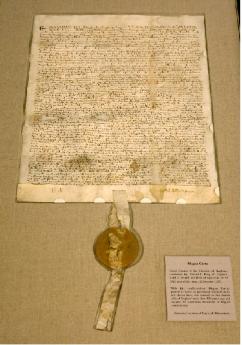
|
| 13th Century Magna Carta |
NATIONAL constitutions are mainly an outgrowth of the 18th Century Enlightenment, even though similar features are to be found among ancient legal codes. Those who trace the origins of the American constitution to the 13th Century Magna Carta will usually point to a central sentence of clause 39:
No free man shall be arrested, or imprisoned, or deprived of his property, or outlawed, or exiled, or in any way destroyed, nor shall we go against him or send against him, unless by legal judgement of his peers, or by the law of the land.
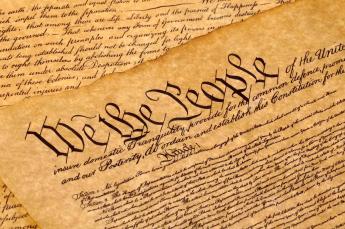
|
| American Constitution |
That's a pretty good beginning, a good example of a needed legal principle, but unrecognizable as what we would today call a Constitution. It states what a government may not do, but does not define the nature of a government which does the job best. Nor do even the many Enlightenment philosophers of government take that final step of outlining where their notions should take us until the American Constitution had been written and defended in the Federalist papers. Nowhere among the writings of Montesquieu (The Spirit of the Laws, 1748), Catherine the Great (Nakaz, Instructions to the All-Russian Legislative Commission, 1767), Diderot (Observations About Nakaz, 1774), James Madison (1787), John Dickinson(1763) or Gouverneur Morris(1787) can there be found much tightly described definition of a constitution. Certainly, there is no definition within the writings of Adam Smith if we look for rule-making among Enlightenment thinkers whose ideas were influential on the 1787 Philadelphia document. The American constitution was the product of many minds, before and after 1787. The outlines of its final form converged, and emerged, from the Constitutional Convention of the summer of 1787, with Gouverneur Morris as the penman of record. To him, we certainly owe its succinctness, which is the main source of affection for the document. That probably understates matters; in his diary of the secret meetings, James Madison records that Gouverneur Morris rose to speak about 170 times, more than any other delegate. Lots of thought and debate; ultimately, few words.
The Elizabethan Sir Francis Bacon has the greatest claim on devising a theory of law and law-making in the Anglosphere tradition. But his elegant modification of Galileo's scientific method, the English Common Law, is more a methodology for creating good laws than an outline of a nation's legal principles. Anyway, tracing the American Constitution back to an underlying British one tends to stumble when the British Constitution fails to meet a definition which would include our own. The British Constitution is said to be "unwritten" to the degree it is a consensus of revered documents. It can be amended by Parliament at will, has a variable history of defining just who is covered by it, and in order to define constitutional principles seems to rely on sentences extracted from difficult context. If the two constitutions had been written and compared at the same time, one would say the British had sacrificed coherence out of respect for tradition. In fairness, some features of the American constitution are also perhaps unnecessary for every constitution, but by surviving as the oldest constitution of the modern form, have become its model. That would be:
A set of principles governing the legitimacy of a nation's laws, and firmly standing above them. It defines its own domain, geographically and by the membership of a defined citizenry. Except as otherwise defined, it supersedes all other governance within its domain. It defines and defends its own origins. It includes a description of how to amend it, which is intentionally infrequent and difficult. It goes on to outline the structure of the laws it regulates, with subtle modifications made to channel the type of power structure which will govern.
In the American case, history and culture generated several other instabilities so central they justified heightening the difficulty to amend them to a Constitutional level, thus conferring undisputed dominance over competing principles of governance. That would be:
A separation of government powers weakened all potentially offending branches of government, and thus enhanced citizen liberty. Separation of church from state, for like purpose. A right of citizens to bear arms, to strengthen citizens' defense against internal or external attack, and perhaps also warning that revolt must be possible, even endorsed, as some final extremity of protection for citizen sovereignty.
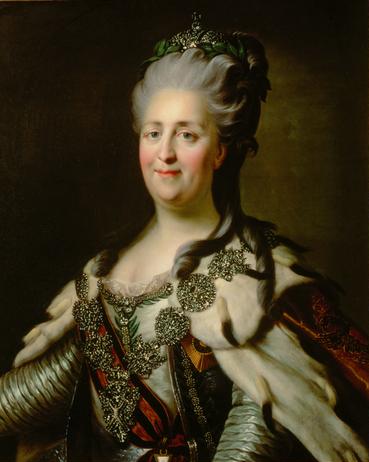
|
| Russia's Catherine the Great |
It enhances our comprehension to contrast the outcomes of competing 18th Century implementations of the Constitution idea. Russia's Catherine the Great proposed a constitution steeped in the traditions of the Enlightenment but ultimately designed to define and strengthen the role of the monarch. Denis Diderot her French protege recoiled at this viewpoint, substituting other views resembling those of Jean Jacob Rousseau. He opened Observations About Nakaz his commentary to the Queen, with the following declaration:
There is no true sovereign except the nation; there can be no true legislator except the people. Whether looking back to the English Civil War or forward to future disputes between the Executive and Legislative branches, it makes clear the Legislative branch was dominant, with the Executive branch acting as its agent.
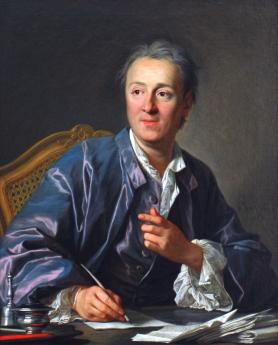
|
| Denis Diderot |
With this ringing warcry, the French model nevertheless ushered in the extremes of the Terror, the Guillotine, and the Napoleonic conquests. The consequences of the French constitution undermined world confidence in the benevolence of public opinion, at least deeply confounding those for whom the democratic rule was not totally discredited. Once more new life was breathed into allegiance for the monarchy, military rule, and dictatorship. Public opinion, it seemed, was not either invariably benign or comfortably far-seeing. The noble savage, mankind naked of tainted civilization, was not necessarily wise or worthy of trust. Edward Gibbons, the 1776 author of The Decline and Fall of the Roman Empire was pointing out where it all might lead if we completely believed in the collective goodness of the human condition. At the least, the failure of the French Revolution complimented the viewpoint of the Scottish philosopher, Adam Smith, who also in 1776 emphatically urged a switch in that reliance toward a sense of enlightened self-interest, as follows:
It is not from the benevolence of the butcher, the brewer, or the baker, that we can expect our dinner but from their regard to their own interest.
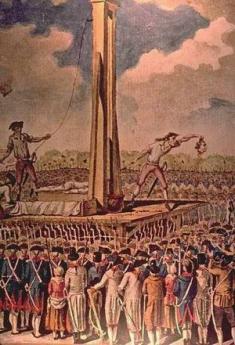
|
| Terror, the Guillotine, |
It is not surprising that Diderot rejected the Leibniz view of things that "All is for the best, in this best of all possible worlds." And, in view of his dependence on Catherine, not surprising he did not publish his rejection of it until 1823. Thomas Jefferson was in France as ambassador during the time of the American Constitutional Convention, fearing to confront George Washington; and likewise keeping his conflicting views private for several years. Eventually, they surfaced in the creation of an anti-Federalist political party along with the conflicts which kept the new nation in a turmoil for the following forty years. It is surely a testimony to the strength of the Constitution's design that the country was able to shift between such extreme governing philosophies but still hold together without changing the governing statement of purpose. Indeed, it is plausible to contend that our two political parties still continuously debate the useful tension between these two differing opinions.
Line Dividing East from West Jersey
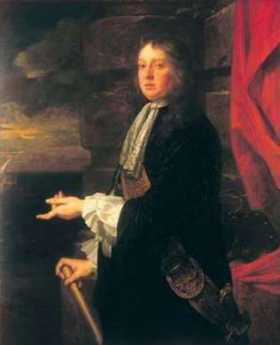
|
| William Penn |
At this point William Penn entered the picture as one of three Quaker trustees for Byllinge, who had gambling debts. A tenth of this share was given to John Fenwick, the 1675 settler of Salem, to settle his part of the disputes with Byllinge; the rest of it constituted what was to become the oldest American stockholder corporation, The Proprietors of West Jersey. The arrangement up to this point was firmly settled for the southern half of New Jersey by a Quintipartite Deed of July 12, 1676, , signed by the three Quaker trustees plus Byllinge and Fenwick. Aside from establishing the Proprietorship, the main point of this deed was the separation of West Jersey from East Jersey (the Carteret part) by a North-South line which still persists as the upper border of Burlington County. The right to govern this land was fully restored in 1680 by a Confirmatory Grant from James, probably after considerable lobbying in London by William Penn.
Presumably in pursuit of this final confirmation, Penn had negotiated a hundred-page agreement with prospective settlers which outlined his plans for governing, called the Concessions and Agreements of March 14, 1677, . Although its original purpose was mainly a real estate marketing tool, this landmark document seems not only to have persuaded the Duke of York but so shaped the thinking of the English colonies that many of its features are readily recognized in the American Constitution of 1787.
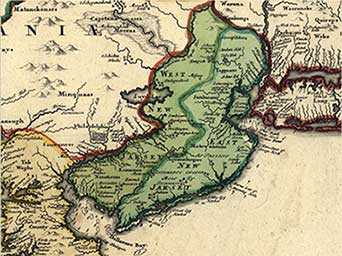
|
| The line dividing West and East NJ |
The land mass between the North and South Rivers (Hudson and Delaware) only came completely and legally into the hands of Quakers in 1681. At that time Carteret's widow, Lady Elizabeth, sold the northern half (East Jersey) to twelve Quaker proprietors, while the southern half (West Jersey) was already held by thirty-two other Quaker proprietors under the effective leadership of William Penn. It is somewhat uncertain who orchestrated this final consolidation, but there is a strong presumption that it was Penn. Since the main purpose of these business proprietorships was to sell land to immigrants, it was vital to minimize land disputes with accurate records and accurate surveying. With a history behind them of fifteen years of bickering, everybody concerned was surely ready for some peaceful organization. Both groups of proprietors, East and West, found it useful to delegate authority to a council of nine executive proprietors, whose main agent under the circumstances was logically the Surveyor General. For the next three hundred years, the surveyor generals were the men running things in New Jersey. The right of the Proprietors to govern was revoked by Queen Anne in 1702, but their land rights remain undisturbed to the present day, notwithstanding the intervening transfer of national power to the United States of America in 1776-83. Underneath all of this hustling and arranging, with exquisite attention to details, seems to be found the hand of William Penn. Almost immediately after New Jersey was packaged and delivered, King Charles paid off his family debt by turning over the far larger combined land mass of Pennsylvania and Delaware to William Penn, urging him to make himself a vassal king in the process. The Quaker instantly declined such a thing, but the power continues to reside in the final Royal Charter. It's only a conjecture, but it might help explain the strange acquaintance between a dissolute king and an abstemious Quaker to notice that the New Jersey tour de force astoundingly demonstrates how Penn was a man who really could be trusted to get complicated things done with dispatch.
Today, for practical purposes it all amounts to a company named Taylor, Wiseman, and Taylor; but we are getting a little ahead of ourselves. To go back to 1684 a surveyed line was clearly needed between the two proprietorships, as declared by the following resolution:
"Award we do hereby declare, that [the line] shall run from ye north side of ye mouth or Inlet of ye beach of little Egg Harbor north northwest and fifty minutes more westerly according to natural position and not according to ye magnet whose variation is nine degrees westward."
To clarify those quaint words, the survey was not to make the mistake made in the layout of Philadelphia, whose streets had intended to be true north and south but by using Magnetic North are actually twelve degrees off from that. Another important point is probably unclear to modern readers, who know the town of Egg Harbor on the mainland of Barnegat Bay but are largely unaware that the "beach of Egg Harbor" was what we now call Long Beach Island, on the east side of Barnegat Bay. The southern anchor of The Line was in what we now call Beach Haven, on the north side of the inlet, although beach erosion has put the southern anchor about two miles out to sea, locating a temporary marker in Beach Haven. Hardly anyone seems to be aware of it, but reread the sentence and observe the meaning is actually quite clear. The intent of the northern end of The Line (? the Delaware Water Gap ?) is buried in the obscurity of compass markings, but comes out slightly above Trenton on the Delaware River, extending beyond the river into Pennsylvania until it reached the river again in a crook on the far side of the Delaware Water Gap. Word of mouth has it that William Penn wanted to have both sides of the river although this triangle of Pennsylvania was eventually surrendered. It seems fair to say, the line was roughly intended to run from the Beach Haven ocean inlet to the Delaware Water Gap.
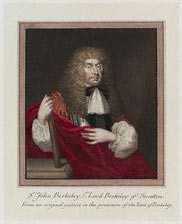
|
| John, Lord Berkeley |
For its time, the survey of The Line was also a significant engineering achievement. The general plan was to lay out the course of the line in the wilderness until it hit a big boulder or anything else that was large and heavy. This became a marker along a line of 150 markers which could be used for local surveys and boundaries. After several less accurate attempts, the West/East line was surveyed by John Lawrence in 1743 and stands as the Official Province Division Line. A few years ago, a group of volunteers tried to locate all of the original markers and found 55 of them. The historical project took ten years.
All of the deeds of property in the State of New Jersey still depend on the original survey and the meticulous notes kept by the Surveyors General of these two Quaker organizations, without whose private records every title to every property would be clouded. With the passage of time, and especially the warfare of the Revolution, other copies of the surveys have disappeared. So, without the need to get ugly about it, these soft-spoken courteous folks retain a form of power it would be hard to match with sticks and stones, guns, threats or legalisms -- the only surviving record of everyone's title to his land. There is little reason to inquire further why these Proprietorships durably survived the revolution which overthrew King George III, and why no one has seen fit to enter the serious challenge to their claim of owning the whole state except for what they had already specifically sold.
Let's go back to a point made earlier. In all the complexities of the English Royal Court and uncertainties of uncharted wilderness, how did a little band of Quakers find themselves with uncontested ownership of a whole American colony? Some of the chaos of the age probably helped. King Charles unleashed his brother's armies in 1664. Also in 1664, Parliament passed the Second Conventicle Act, which provided that not more than five persons were permitted to worship together otherwise than according to the established ritual of the Anglican Church of England. This act might be described as an improvement on the First Conventicle Act of Queen Elizabeth, which provided that no one at all could so worship. However, this prohibition was so extreme it was ignored, whereas the Second Conventicle probably had some popular support. It thus can be imagined why Quakers were suddenly interested in leaving England, and not hard to understand how young William Penn was propelled into leadership by successfully overturning that Act in the Haymarket Case. Penn was both the defendant in the case and the defense lawyer, inventing the common law principle of jury nullification that has so confounded tyranny ever since. To go on with events current at the time, the Great Plague took place in 1665, making London an undesirable place for anybody to live. And finally, George Fox, the founder of Quakerism, took a journey to the new world in 1672, noting that the place now called Burlington, New Jersey was "a bravest country". Taken altogether, it is not hard to suspect this group of fairly wealthy, fairly well-educated people developed a collective resolve to buy up the pieces, assemble the parcel, and go away to live on it. Their organization into monthly local meetings, quarterly regional meetings, and annual national meetings was surely great assistance. From what we know of the broader vision of William Penn, it is fair to speculate his enthusiasm for this communications network first suggested by George Fox, or at least he's having a pretty quick recognition how it would assist the emigration venture.
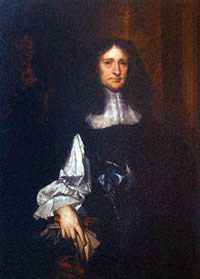
|
| George Carteret |
George Carteret's widow was the last to sell out her land parcel to the East Jersey Proprietors, presumably drawn from the 1400 immigrants who had arrived in Burlington on five or six ships between 1678 and 1681. In particular, the ship Kent sailed from the Thames in 1677, bearing 230 Quakers, half from Yorkshire, the other half from London settling further south in West Jersey. Before that, Lord Berkeley had sold his half for a thousand pounds to John Fenwick and Edward Billynge, who arrived in Salem on the ship Griffin in 1674. These two soon fell out, with Fenwick taking a tenth of the land and settling around Salem. Billynge got into unspecified difficulties, probably gambling, and turned his property over to his three main creditors, William Penn, Gawen Lawrie, and Nicholas Lucas, who assembled the Proprietorship of West Jersey. Penn's remarkable talent for leadership again emerged in his statement of "Concessions and Agreements" with the Indians and new inhabitants. In another place, we discuss the reasons for thinking this document created the effective basis of the U.S. Constitution. By infusing it with the unspoken word of compromise, Penn created the main model explaining why the ratification of the Constitution remains the only time in history when thirteen independent nations voluntarily gave up sovereignty for the purpose of creating a larger vision -- which then held together for two centuries. But the voluntary union of East and West Jersey certainly has a claim to being earlier, although its claim to sovereignty is weaker.
Perhaps so, but since their interest in power was weaker, their achievement in peaceful negotiation with a secretly Catholic King was surely much greater. If some small group of religious dissidents should today emerge as having quietly and systematically bought up an entire state, however legally, the word conspiracy would be on every tongue. In this case, however, the reaction was peaceful consensus.
25 Blogs
A Time to Read Books
 Retirement is a good time to read all those books you meant to read. But certain things stand in the way.
Retirement is a good time to read all those books you meant to read. But certain things stand in the way.
Germantown Nurses the Yellow Fever, 1793
 Refugees from Haiti slave revolts brought Yellow Fever to south Philadelphia.
Refugees from Haiti slave revolts brought Yellow Fever to south Philadelphia.
Two Friends Create the Articles of Confederation
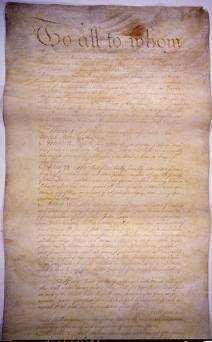 John Dickinson and Robert Morris were good friends who pushed the Articles of Confederation through to ratification. Both of them had been active critics of Great Britain's treatment of the colonies, but both hesitated to sign the Declaration, and both later relented and fought for Independence. Dickinson's final position is less clear, but it was Morris who first saw the weakness of the Articles, and pressed on for their replacement by the Constitution.
John Dickinson and Robert Morris were good friends who pushed the Articles of Confederation through to ratification. Both of them had been active critics of Great Britain's treatment of the colonies, but both hesitated to sign the Declaration, and both later relented and fought for Independence. Dickinson's final position is less clear, but it was Morris who first saw the weakness of the Articles, and pressed on for their replacement by the Constitution.
Signers and Non-Signers of the Constitution
 Seventy delegates were invited to attend the Constitutional Convention, fifty-five attended the sessions, but only thirty-nine signed it. Considering that Rhode Island refused to send delegates, that sounds like a closer vote than it really was. But it was definitely not unanimous.
Seventy delegates were invited to attend the Constitutional Convention, fifty-five attended the sessions, but only thirty-nine signed it. Considering that Rhode Island refused to send delegates, that sounds like a closer vote than it really was. But it was definitely not unanimous.
The Schools of School House Lane
 Exclusive privates schools and colleges are usually to be found in isolated rural settings. But our oldest, best, and most famous schools are clustered together in a neighborhood that is far from exclusive.
Exclusive privates schools and colleges are usually to be found in isolated rural settings. But our oldest, best, and most famous schools are clustered together in a neighborhood that is far from exclusive.
SEPTA's Long Term Planning
 SEPTA is slowly making progress, but it's a struggle, every step of the way.
SEPTA is slowly making progress, but it's a struggle, every step of the way.
Funny Toes: A Physician Viewpoint
 Most people either ignore funny toes, or hide them in their shoes. Here are one doctor's idle thoughts about them.
Most people either ignore funny toes, or hide them in their shoes. Here are one doctor's idle thoughts about them.
What Happened in Philadelphia on July 4, 1776?
 There were about 30,000 residents, just a small town, but it was the second largest city in the English-speaking world. Aside from wagons, there were thirty wheeled vehicles. But this is the town where decisions were made.
There were about 30,000 residents, just a small town, but it was the second largest city in the English-speaking world. Aside from wagons, there were thirty wheeled vehicles. But this is the town where decisions were made.
Northwest Ordinance of July 13, 1787: Articles of Confederation at their Best
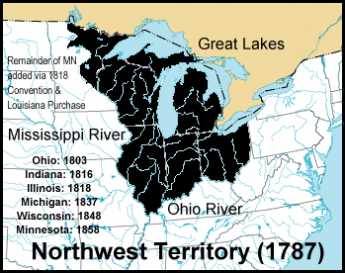 The British took over the Northwest Territory from France at the 1763 Treaty of Paris. The United States then acquired it at the second Treaty of Paris, ending the Revolutionary War, in 1783. The Northwest Ordinance of 1787 established rules for governing the Territory, as just about the last act under the Articles of Confederation.
The British took over the Northwest Territory from France at the 1763 Treaty of Paris. The United States then acquired it at the second Treaty of Paris, ending the Revolutionary War, in 1783. The Northwest Ordinance of 1787 established rules for governing the Territory, as just about the last act under the Articles of Confederation.
Political Parties, Absent and Unmentionable
 Our Constitution is much praised for exquisitely balancing power between the three branches of government. It would even be an achievement to require two centuries to find a way to unbalance them.
Our Constitution is much praised for exquisitely balancing power between the three branches of government. It would even be an achievement to require two centuries to find a way to unbalance them.
Cost of Medical Care
 Milton Hershey agreed to fund the Hershey Medical School out his own pocket, after a ten-minute conversation.
Milton Hershey agreed to fund the Hershey Medical School out his own pocket, after a ten-minute conversation.
A Change of Era
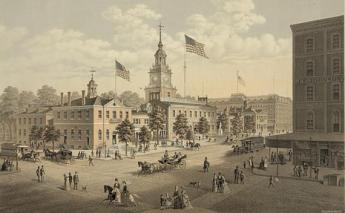 Few historical eras burst upon the world with the suddenness of the American one. It took place in Independence Hall, all right, but even more decisively in 1798 than 1776.
Few historical eras burst upon the world with the suddenness of the American one. It took place in Independence Hall, all right, but even more decisively in 1798 than 1776.
The First and Oldest Hospital in America
 The history of American medicine is the history of the Pennsylvania Hospital.
The history of American medicine is the history of the Pennsylvania Hospital.
Lindbergh Baby Kidnapping Trial
 Bruno Richard Hauptmann was surely guilty of something, although it remains doubtful if he deserved to be electrocuted for the death of Charles Lindbergh's baby.
Bruno Richard Hauptmann was surely guilty of something, although it remains doubtful if he deserved to be electrocuted for the death of Charles Lindbergh's baby.
Philadelphia Mafia: The First Fifty Years
 For forty years after 1880, The Philadelphia Mafia was a small vigilante group secretly protecting Sicilian immigrants from marauding gangs of local Italians, which were definitely not the same thing. Prohibition transformed the whole nature of the underworld.
For forty years after 1880, The Philadelphia Mafia was a small vigilante group secretly protecting Sicilian immigrants from marauding gangs of local Italians, which were definitely not the same thing. Prohibition transformed the whole nature of the underworld.
Google Earth Tour of Franklin Locations
 Every place B. Franklin is known to have visited is included in this tour by Bob Florig.
Every place B. Franklin is known to have visited is included in this tour by Bob Florig.
Ageing Owners, Ageing Property
 From Japan, we get a fresh view of our assets. Kiyohiko Nishimura observes that the price of a house, even of a stock portfolio, has something to do with the age of the owner who is selling it.
From Japan, we get a fresh view of our assets. Kiyohiko Nishimura observes that the price of a house, even of a stock portfolio, has something to do with the age of the owner who is selling it.
Anatomy of an Urban Political Machine
 If Philadelphia is typical, here is how urban machine politics works.
If Philadelphia is typical, here is how urban machine politics works.
A Gleam in Washington's Eye
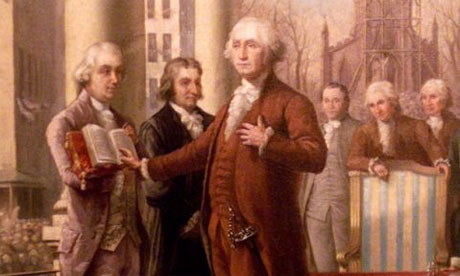 Section 8 of Article I of the Constitution contains the enumerated powers of Congress, and Section 9 contains some prohibitions of Congressional power. Taken together, these "powers" constitute the arguments that a Union is superior to a Confederation. In the aggregate, they represent the reasons why we created a Union.
Section 8 of Article I of the Constitution contains the enumerated powers of Congress, and Section 9 contains some prohibitions of Congressional power. Taken together, these "powers" constitute the arguments that a Union is superior to a Confederation. In the aggregate, they represent the reasons why we created a Union.
Limits of Leverage
 The American Revolutionary War was supposed to lead to paradise, but nobody was very happy with the state of affairs it left behind.
The American Revolutionary War was supposed to lead to paradise, but nobody was very happy with the state of affairs it left behind.
The Girl in the Red Velvet Swing
 The original Gibson girl's husband was rich, her boyfriend was famous. But blowing somebody's brains out in public is supposed to be a felony.
The original Gibson girl's husband was rich, her boyfriend was famous. But blowing somebody's brains out in public is supposed to be a felony.
Itch
 Bad skin is one thing, itchy skin is another.
Bad skin is one thing, itchy skin is another.
What Is the Purpose of a National Constitution?
 The primary purpose of any Constitution is of course survival. Usually, but not invariably, that means avoiding war with a neighbor which will surely beat you. Having stated what ought to be obvious, the framers of a Constitution need to be careful of the reasons which originally caused the new state to be formed, and also need to avoid provisions which would cause trouble by inciting some different type of governance. These features can be enumerated, but are easily forgotten.
The primary purpose of any Constitution is of course survival. Usually, but not invariably, that means avoiding war with a neighbor which will surely beat you. Having stated what ought to be obvious, the framers of a Constitution need to be careful of the reasons which originally caused the new state to be formed, and also need to avoid provisions which would cause trouble by inciting some different type of governance. These features can be enumerated, but are easily forgotten.
Line Dividing East from West Jersey
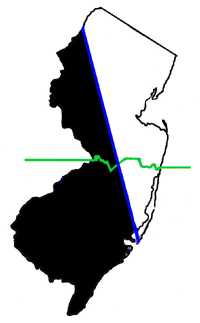 Although England had owned New Jersey for 17 years, it was unsettled until purchased by Quakers. By 1684 ownership was totally in the hands of two Proprietorships, or corporations, of Quakers. The boundary separating East from West Jersey was a line of 150 boulders from Beach Haven to Trenton. Every land title in the state is based on this survey.
Although England had owned New Jersey for 17 years, it was unsettled until purchased by Quakers. By 1684 ownership was totally in the hands of two Proprietorships, or corporations, of Quakers. The boundary separating East from West Jersey was a line of 150 boulders from Beach Haven to Trenton. Every land title in the state is based on this survey.
